Last Updated on November 11, 2023 by asoulwindow
Table of Contents
About Gwalior Fort
Gwalior Fort is one of the top places to see in Gwalior. The main fort of Gwalior is so big that there are roads inside the fort premises, it is like a mini township with temples, palaces, lawns and even a functioning heritage school. Accessed by the Urwai gate, places like the Siddhanchal rock cut Jain statues, ASI Museum, Karan Mahal, Vikram Mahal, Teli ka Mandir, Saas Bahu Mandir, Dhondapur Gate, Jauhar Kund, Fort Bastion Hamamkhana, Bandichor Gurudwara and Scindia School are some of the best tourist places to see in the Gwalior Fort premises.
This is the most comprehensive travel guide to the Gwalior Fort ever. Show me a bigger travel blog on Gwalior Fort and I shall show you a live dinosaur! I have mentioned in detail about each place you can see in the premises of the Gwalior Fort in this exhaustive travelogue.
Such rare information is not available in the old school newspapers, travel magazines and travel guide books. Do share this blog with your friend and family so that more and more people learn about the things to do in Gwalior Fort. I am sharing many trivia and fun facts about the Gwalior Fort in this exhaustive blog. Here is all you wanted to know about the Gwalior Fort.

My Experience of visiting Gwalior Fort
I was transported back in time as I uncovered Gwalior Fort one layer at a time.For a history buff like me,a visit to the Gwalior fort was like moving into a time warp. As I enter the time warp which Gwalior Fort is, every stone of its walls spoke volumes about the endless series of dynasties which won and lost this ancient bastion. It is not every day that I see such huge fort premises.
I was invited by the Time Passion Trails in association with Madhya Pradesh Tourism for a weeklong trip across Gwalior and nearby attractions. As much as I learnt about unheard of places, many of which were off the touristy trail, I also had an amazing time bonding with friends who were also on this trip. Good company, exciting destinations and amazing chemistry between all the participants made this trip memorable.
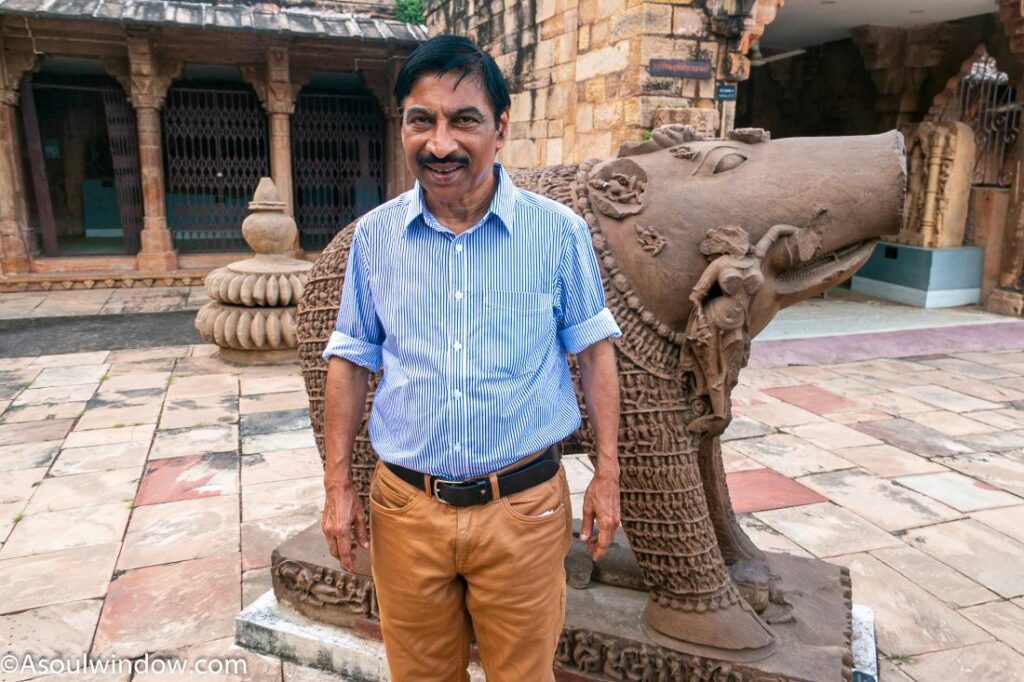
Why is Gwalior Fort famous?
Thanks to its unique history and the stunning architecture of palaces and medieval temples, Gwalior Fort is famous across the world. I was also treated with unforgettable views of the Gwalior city from this sprawling fort.
Gwalior Fort is known for its strategic location, scale, rich history and grand architecture. What also makes the Gwalior fort so famous is the fact that it is one of the largest forts of India. The fame of the Gwalior Fort continued for centuries as it exchanged hands from one dynasty to another. Gwalior was one of the most important political bastions of the bygone era. This is why Gwalior fort always stayed important and relevant throughout the centuries. No prizes for guessing, the Gwalior fort is still one of the most famous forts of India.
Who is the main deity of Gwalior Fort
Shiva Bhagwan and Vishnu Bhagwan
are the main deities whose temples are built across the Gwalior Fort. I visited many Hindu temples as I hopped from one tourist attraction to another while visiting the Gwalior Fort.
Nomenclature/Etymology of Gwalior Fort
Gwalior Fort is also known as the Gwalior Kila or Gwalior Qila. Did you know that the word Gwalior is a derivation of the word Gwalipa. As per the local folklore, the local chieftain Suraj Sen founded the city of Gwalior in the name of Gwalipa because he cured him of leprosy.
Where is Gwalior Fort located?
Gwalior Fort is located in the heart of the Gwalior City in Madhya Pradesh in Central India. Gwalior Fort is perched atop a sandstone hill because it provides a natural defence advantage to the fort. Its strategic location reminded me of the colossal Mehrangarh fort of Jodhpur in Rajasthan.
Who built Gwalior Fort?
Gwalior Fort was built and renovated by many dynasties over several centuries.
Who ruled Gwalior Fort?
Not many people know that this hill fort was ruled by various dynasties of different kingdoms over several centuries. Below are some of the main rulers of Gwalior Fort:
History of Gwalior Fort
As we have seen above, Gwalior Fort has had a very rich history which spanned centuries. From Kachchhapaghata rulers to brave Tomar Rajputs; from Mughals to the Scindias and British, everyone finds a mention in the annals of history here. Keep reading, as I share some of the most fascinating facts about the Gwalior Fort of Madhya Pradesh in Central India.
Mughal Invasion: Who attacked Gwalior Fort?
Gwalior Fort is known to be one of the most impenetrable forts of India. However, in the year 1527 C.E., the army of Mughal ruler Babur attacked the Gwalior fort. Known to be iconoclasts, the army destroyed the faces of deities, whether Hindu Gods and Goddesses or Jain Tirthankaras.
The signs of defacing the idols can still be seen today. I also noticed that the army of Babur had also destroyed the genitals of the idols of the naked Digambara Jain Tirthankaras. But the good news is that except for the faces and genitals of few statues, much of the Rock cut images of the Tirthankaras are still intact and in good shape.
When was Gwalior Fort constructed?
How old is the Gwalior Fort? Did you know that the Gwalior Fortis one of the oldest forts in Madhya Pradesh as well as in India? After a deep study, the archaeologists, scholars and historians have concluded that Gwalior Fort is at least more than a thousand years old, maybe more! The origins of Gwalior Fort can be traced back to the Tomar dynasty. However, historical records which date back to 3rd and 4th century have also been observed in Gwalior Fort.
What is Gwalior Fort made up of?
Gwalior Fort is built with Vindhyan sandstone, lime and mortar. It was easy to see why Gwalior Fort is so robust and impenetrable. The fort walls here are one of the tallest I have seen yet (and I have seen a lot!). No wonder, the strong medieval structures here still stad strong even after so many centuries.
What are the main entrances of Gwalior Fort?
What is the name of the gate in Gwalior Fort? Hathi Pole and Urvai Gate are the main entrances of the Gwalior Fort.
Which gate is best for Gwalior Fort? I entered from the Urvai Gate because it is walking distance from the Siddhanchal rock cut Jain temples, Man Singh palace, Johar sthal, Chaturbhuj Temple etc.
The lesser-known Dhondapur Gate and Ladhedi gate are also other entrances to Gwalior Fort. These are some of the best kept secrets of the Gwalior Fort.
How many gates are there in Gwalior Fort?Overall, there are 6 gates inside the Gwalior fort.
Area of Gwalior Fort
The sprawling Gwalior Fort is spread across an area of a whooping 3 square kilometres. This makes it one of the largest forts in India and Asia.
Architecture of Gwalior Fort
What is the architectural style of Gwalior Fort? The architecture of Gwalior Fort is spellbinding, to say the least. Fortified by solid sandstone walls, the Gwalior Fort is home to three temples, many water tanks and as many as six palaces. This architectural marvel is to be seen to be believed. Though it is not rare to find such grand ruins in India, I was still spell bound by the sheer scale and architectural brilliance of the monuments within the walled premises of the massive Gwalior Fort.
What are the architectural features of Gwalior Fort? While studying the minute details of various monuments of the Gwalior Fort, what I found most interesting is amalgamation of several architectural styles. Rajput, Mughal and Hindu architectural styles could still be easily seen on the walls of Raja Man Singh Palace etc. This blend of architectural styles speaks volumes about various dynasties who ruled Gwalior and the surrounding region over several centuries.
Light and Sound Show at the Gwalior Fort
During my lonely post prandial walk on the roof top terrace of the luxurious Taj Usha Kiran Palace, I was swept off my feet when my eyes rested on the beautifully lit Gwalior Fort. It looked ethereal and reminded me of the forts of Rajasthan which are also lit beautifully in the night! Did you know that it is possible to visit the Gwalior fort even during the night? How cool is that! Much like how I visited Petra in night during my weeklong trip in Jordan in Middle East!
The 45 minutes long Light and Sound Show at the Gwalior Fort is not to be missed.
The timings of Light and Sound Show at the Gwalior Fort are
March to October:
Hindi: 7:30 p.m. and
English: 8:30 p.m.
November to February:
Hindi: 6:30 p.m. and
English: 7:30 p.m.
Top places to see in Gwalior Fort
Till I visited, I had no idea that there are so many exciting places to visit in the Gwalior Fort Complex. This fort is so huge that even a day is not enough to explore all its corners in depth. Till I visited, I had no idea that the famous Raja Man Singh Palace, Chaturbhuj palace, Jahangir Mahal, Shahjahan Mahal are also located within the premises of the Gwalior Fort. Below are some of the best places to see in the Gwalior Fort premises.
Raja Man Singh Palace: Top Place to see in Gwalior Fort
As soon as I arrived at the Gwalior Fort, few local kids asked me to pay them a fortune in promise of a magic show! But the real magic was unfolding right before my eyes! The blue glazed tiles, figures of ducks, elephants etc on the fort walls and blend of Hindu and Islamic architecture made it one of the most unusual forts I have ever seen.
Leading India archaeologist of ASI, K.K. Muhammed sir told us stories behind the small details on the walls of the temple, “You see this, that’s a Hindu element! That part is Islamic architecture!” I listened to K.K. Muhammed sir, agape mouthed as he made us see the what our untrained yes failed to.
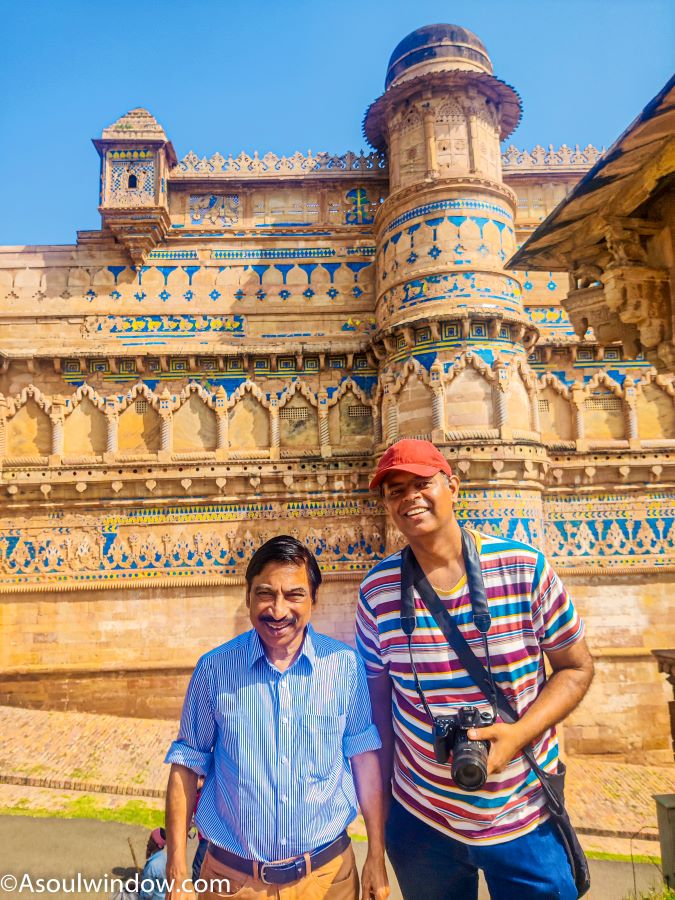
As per the ASI signboard,
Raja Man Singh Palace is one of the finest examples of Hindu architecture. It was built by Tomar King Man Singh Tomar in the year 1508 C.E. Overall, Raja Man Singh palace has 4 storey, 2 of which are underground. The plan of the third storey consists of 2 open courtyards and various rooms supported by different decorated pillars and brackets. There are jhulaghar, kesar kund and phansighar below this storey.
The palace is decorated with beautiful paintings, glazed tiled of different colours, various figures such as plantain trees, ducks, peacocks, elephants, human beings, lions and attractive pillared domes.
The palace is constructed on the outer wall of the Gwalior fort, raised over the cliff at about 300 feet from the ground level. Unfortunately, in the 16th century C.E. when the fort was attacked and captured by the Mughal army, Raja Man Singh palace was used as a state prison.
I visited all the parts of the Raja Man Singh Mahal, including the basement which was used as a spot for performing Jauhar by the queen. The interiors of the Raja Man Singh palace are even more stunning. The glazed blue tiles make an appearance again. Large courtyards, several rooms, narrow stairs, secret passages are some of the highlights of this grand palace. K.K. Muhammed sir took us to the ladies’ quarters, where they would see the proceedings from the privacy of the room.
He added, “Khus curtains which are made with vetiver grassroots work as a natural coolant. This part was covered with khas ki tattiyan or Khus curtains during summer to keep the temperatures low.” Some natural air cooling this! The bygone era was indeed a carbon-negative world!
Siddhanchal rock cut Jain statues
My jaws dropped as I came across the imposing fort walls of Raja Man Singh Palace from the Urwai gate of Gwalior Fort. The Siddhanchal rock cut Jain idols fell on my right as well as my left as I approached the Raja Man Singh Palace.
These colossal idols were chiselled between 7th century C.E. to 15th century C.E. Sadly, Babur from the Mughal dynasty ordered destruction of these beautiful idols in the 16th century. Later some of these were restored. However, I was heartbroken to see some of these idols without a face. The idols here depict all the 24 Jain Tirthankaras. Siddhanchal rock cut Jain idols are not to be confused withsimilar idols at Gopachal Parvat which is located outside the Gwalior Fort.

The 58.4 feet or 17.8 metres tall idol of Lord Rishabhanatha is a must-see here. He is also associated with Kailash Parbat which is now located in Tibet. Do read my blogs on the epic Kailash Mansarovar Yatra, a spiritual journey which changed my life!
There are several caves, small reliefs on the walls and 22 colossi here. You can also take the stiars to go down and have a closer look. Do not miss visiting the Siddhachal Jain collosi cave temples.
Chaturbhuj Temple- The Zero temple no one told you about!
Did you know you can see the earliest known written documentation of Zero in the world in the Chaturbhuj Mandir? This is one of the lesser-known fun fact about Gwalior Fort.
Located within the premises of the huge Gwalior Fort, the Chaturbhuj temple is a must-visit tourist attraction.
Soul Window Thoughts
It is a well-known fact that Aryabhatta (476–550 CE), a mathematician-astronomer from ancient India has given 0 to the world. You may not have noticed, but it is the zero which is running the world today. Be it computers, mobiles, economics or geo politics, you can’t move an inch without the inevitable zero. Thanks to its importance, many international tourists also ensure they visit the Chaturbhuj Temple.
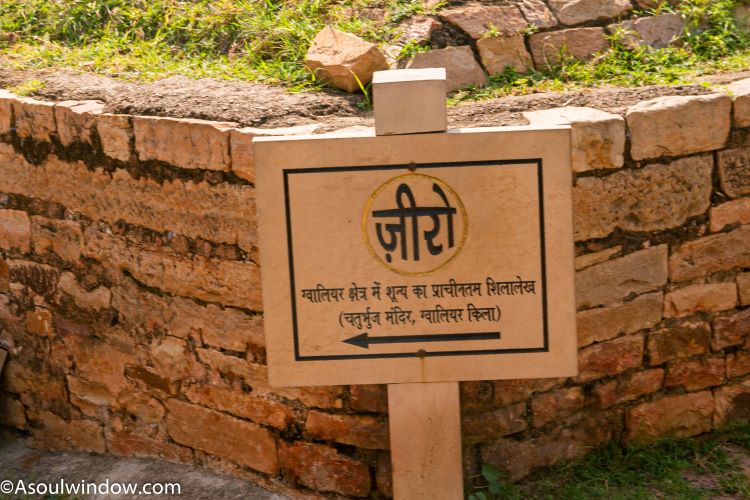
It is easy to miss the Chaturbhuj Temple because it takes a bit of an effort to reach here. The sloping road (yes, this fort has tar roads, eh!) at the intersection of the Raja Man Singh Palace and Gwalior ASI Museum leads to the Chaturbhuj Mandir. I didn’t need to ask for directions as the signboards clearly mention it. You must visit the place with a local guide who can not only help you spot the zero but also explain the history of the place.
Teli Ka Mandir: Best Place to visit in Gwalior Fort
Devoted to Vishnu Bhagwan, the preserver and protector of the Universe, Teli Ka Mandir is located within the premises of the sprawling Gwalior fort. Apart from the odd name, the first thing I notice as I enter the main gate was that how tall this temple is. The modern patchwork on the upper part of the temple also caught my attention. India’s celebrity archaeologist K.K. Muhammed sir told me that it was the restored part of the temple. He further added that the Archaeological Survey of India or ASI takes care of the maintenance and upkeep of Teli Ka temple.
What also intrigued me was the huge size of the garbhagriha or sanctum sanctorum, accessed by a short flight of stairs. It is not very often that I see garbhagriha as big as this. But the spartan garbhagriha was empty. Neither was there any idol nor any adornment. It is lost to time. How did we then figure out that this temple is devoted to Vishnu ji. K.K. Muhammed sir taught me how to identify a Vishnu temple, only after chanting a few mantras with the same ease and sincerity of a child reciting poems. He pointed out to the beautiful Garuda figure on the main doorway. Where there is Nandi, there is a Shivalinga and where there is a Garuda, there is Vishnu ji.

As is common in temples of this region, the images of holy rivers Maa Ganga and Maa Yamuna flank either side of the temple doors. This 100 feet tall ancient Hindu shrine located in the Northern Indian state of Madhya Pradesh is also the oldest and tallest structure found within the Gwalior Fort complex.
Why is it known as Teli Ka Mandir or Telika Temple? Well, the Teli community or the oil merchants from that era are credited as the builder of this temple, which is why it is also known as the Oilman’s temple. Constructed in 8th or 9th century C.E., the unusually named Teli Ka Mandir is one of the top places to see in Gwalior Fort.
A unique blend of the North Indian Nagara and South Indian Dravidian style of architecture, I was awestruck with the sheer grandeur of the temple. I circumambulated around the temple, admiring the beauty of each of its carvings, most of which depicted sculptures of various Hindu deities. The more I see, the more I discover.
The oblong vaulted roof constructed in the Buddhist style adds to the uniqueness to this unusual temple. The The rectangular design of Telika Mandir is unusual as well. Shaiva and Shakta Dwarpalas in the inner and outer doorways corresponds to the worship of Goddess Shakti. Unlike many nearby temples, there is no mandap here.
Saas Bahu Mandir: Must-see place in Gwalior Fort
These 11th century twin temples of Gwalior Fort are a must-visit. Devoted to Vishnu Bhagwan in his Padmanabha form, I was crestfallen to see that the tower of the temple has fallen off. Constructed in the North Indian Bhumija style architecture, these temples look magnificent even if partially ruined. Luckily the entrance porch, rich carvings and the mandapa have survived the test of time.
The stone inscription found on the portico of the bigger Saas mandir mentions the details about its construction along-with funds allotted for the temple and mention of religious congregation, folk rituals etc.
The carvings of Brahma, Vishnu and Saraswati above its entrance door are awe-inspiring. I walk around the temple premises, admiring the ceiling and pillars which depict the carvings on Shaktism, Vaishnavism and Shaivism.
I noticed the Krishna-leela scenes and image of garuda on the walls of the bigger Saas temple. The external walls of the saas temple beautifully carved with geometric designs, musicians, dancers, floral patterns, elephant figures etc. The architectural grandeur of the saas-bahu temples is a perfect representative of the temple building tradition of the Kachchhapaghata rulers.
The smaller bahu temple, offers breathtaking bird’s eye view of the Gwalior City. Much like the bigger Saas temple, the Bahu temple is also embellished with beautiful designs and patterns. It comprises of a vestibule and a small central hall.
Sasbahu Temple which is also known as the Sahasrabahu Temple, Sahastrabahu Temple, Sas-Bahu Mandir, Harisadanam temple or Sas-Bahu Temples is one of the best places to see in Gwalior Fort. Located on the eastern corner of the Gwalior Fort, the construction of this temple was started by started by King Ratanapala. The temple was however completed later during the rule of King Mahipala in the year 1093 C.E.
Why is Saas Bahu temple called so? The literal translation of Saas-Bahu is mother-in-law and daughter-in-law respectively. The Saas temple corresponds to the bigger temple while the bahu temple corresponds to the smaller temple. The original name of the Saas-Bahu temple was however, Sahastrabahu temple. Sahastrabahu means: thousand arms. Gradually, the locals started calling it as Saas-Bahu mandir.
As per the signboard,
“The fully developed temple plan is aligned in North-South direction having garbhagriha, antarala mahamandapa and ardhamanapa from South to North. The exuberantly carved pillars and ceilings of the central hall are flanked by porches on the 3 sides.”

Gwalior Fort Museum or ASI Archaeological Museum
Gwalior Fort Museum is located at walking distance from the Raja Man Singh Palace. Established as recently as the year 1993, the ASI Archaeological Museum, this unique museum is a former jail which was subsequently used as a hospital in the colonial era. This museum is not to be confused with the state run museum situated in the premises of the sprawling Gujari Mahal at the foot of the hill. Gwalior Fort Museum, though smaller than the Gujari Mahal Archeological Museum, is still a treasure trove of various idols and artefacts from the bygone era. The signboards in Hindi and English add context to the displays. The ASI Museum of Gwalior provides an excellent opportunity to appreciate the traditions and styles of art, from nearby important historical destinations like Padhawali, Bateshwar, Sihonia, Pawaya, Surwaya, Amrol, Terahi, Kherat, Naresar and Ater.
Some of the notable exhibits here include:
It takes around 30 minutes to 1 hour to see all the displays at the Gwalior Fort Museum or ASI Archaeological Museum. I would suggest that you club a visit to the museum alongside the Raja Man Singh Palace.
Dhondapur Gate
Dhondapur Gateis one of the less talked about places to see in the Gwalior Fort. As opposed to the popular Urwai gate, the Dhondapur Gate is a hidden gate of Gwalior Fort. As per the signboard, the Dhondapur Gate of Gwalior Fort is located in the same direction as the area which houses Karan Mahal, Jehangir Mahal etc. You can visit it right after visiting the Raja Man Singh Palace.
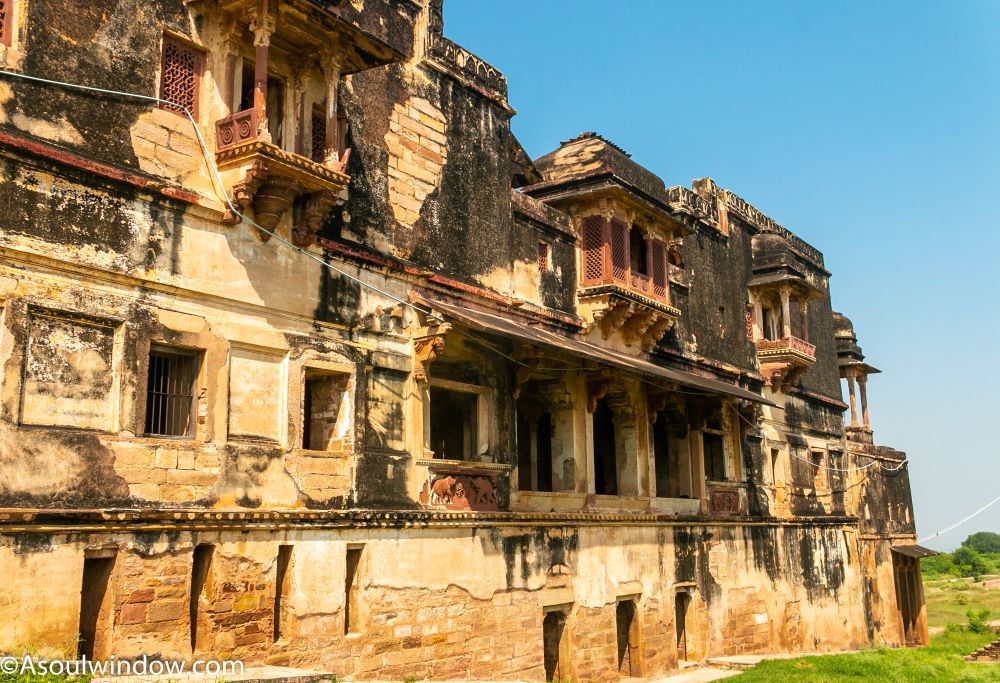
Karan Palace
Also known as the Karn Mahal, it is one of the best state protected monuments inside the Gwalior Fort. Offering grand views of the city below, the Karan Mahal is one of the top sightseeing places in the Gwalior Fort. Karan Palace is located right opposite the Vikram Mahal. Constructed by Kirti Singh, who happened to be the 2nd king of the powerful Tomar dynasty, the grand Karan Mahal is a sight to behold. It is a delight that much of its structure still stands tall.
Despite the simple structure of the Karan Palace, this medieval edifice stands out with its sheer size. The lattice-screens and sculptures are cherry on the cake. Very well restored, Karan Palace is older than Man Mandir.
Jauhar Kund of Gwalior Fort: The Biggest ever?
“I refuse to believe that the Jauhar Kund of Chittorgarh is the biggest. I am certain that the Jauhar Kund of the Gwalior Fort is the biggest ever. It is just that no one talks about it!”, my local tour guide announced with the same conviction and a tone of finality, with which he said later that “It was in Madhya Pradesh and not Maharashtra that Ganesh Chaturthi processions started.”
He may be right. History often gets lost in translation and protocols and the same narrative runs for centuries without any one daring to question the accepted. Did you know these interesting fact about Gwalior Fort?
The huge Jauhar Kund is where the Rajaput Queens and their maids self-immolated themselves to save themselves from the barbaric attack of the invader. This huge water tank was originally constructed in order to provide water all around the fort. Unfortunately, it ended up becoming the venue of Jauhar for large number of women during Islamic attacks. This event took place when the ruler of Gwalior was attacked by the invading army. It was one of the worse ever Islamic attacks on the Gwalior fort.
As per the noted historian Mata Prasad Shukla, Khadag Rai, the writer in the court of Akbar had written a book known as Gopachal Akhyan in which he mentioned that in the year 1232 C.E. that Shamsuddin Iltutmish had attacked the Gwalior Fort from all the corners despite the structure build atop a slopy hill. The battle continued for a long time. Even though Iltutmish and his army had a disadvantage because the fort was perched atop an elevation, they didn’t give up on the attack.
Eventually, due to the depleting resources and logistics inside the fort, the battle had to be moved to open field. This was the undoing for the King and the inhabitants of the Gwalior Fort. Their army was lesser in numbers than that of Iltutmish. No prizes for guessing it was a one-sided war.
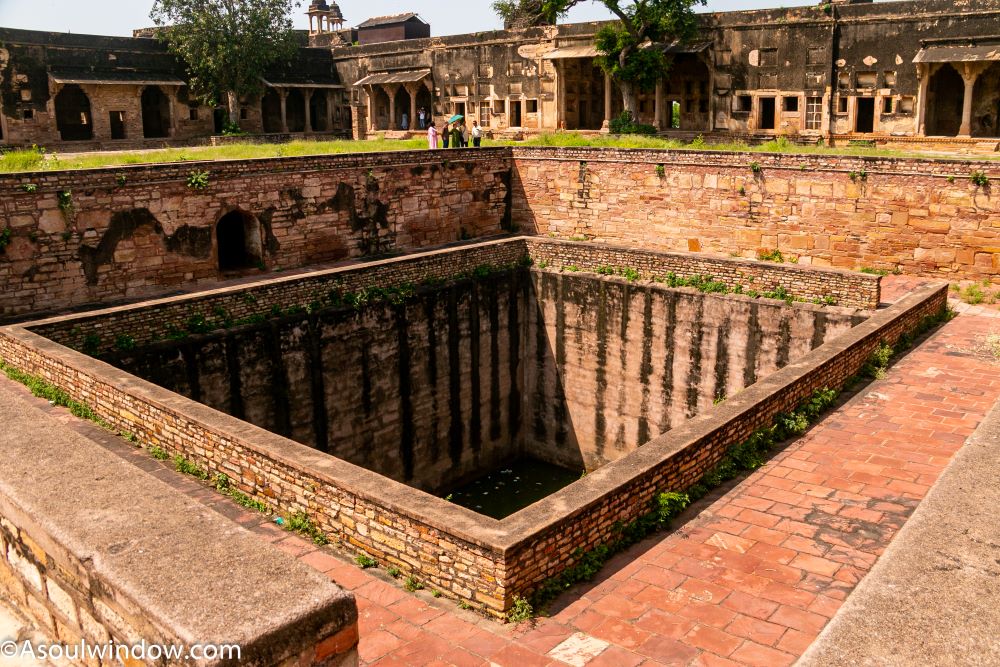
Sensing defeat and sexual slavery by the winning army, the queen and her maids self-immolated themselves in this huge water tank, saving not just their bodied but also their honour and self-respect! A similar goose-bumpy scene also can be seen in the Bollywood movie Padmavat. This scene is also available on Youtube. After this unfortunate event, this water reservoir came to be known as Jauhar Kund or Jauhar Sthal.
Soul Window Ruminations!
I stood there, in silence, numb with all the horrors of the atrocities committed in the past! The melancholy of the place was growing on me, even as the tourists scattered around the fort chirped around, oblivious to the pains the Indians of the bygone era went through. I have nothing but respect for these valiant women, who offered themselves to agni (fire) than to the barbaric invading army!
These practises were very common in medieval India, especially in the North. These brave women would rather self-immolate themselves, than be sexually misused in the harems of the winning army! There is indeed a lot we can learn from the history! But then history often repeats itself.
The Jauhar Kund or Jauhar Sthal is located near the Cenotaph of Bhim Singh Rana and towards the west of the Jehangir Mahal.
Cenotaph of Bhim Singh Rana
This 3-storeyed cenotaph, flanked by a dome is not to be missed. Located near the Jauhar Kund, you can easily visit this place while exploring the Gwalior Qila.
Cenotaph of Bhim Singh Rana or the Chhatri of Bhim Singh Rana is one of the lesser-known places to see in the Gwalior Fort. Also known as Bheem Singh Rana Ki Chhatri, it was built in the memory of Bheem Singh Rana, the King of Gohad, Bhind (in Madhya Pradesh) who ruled between 1717 and 1756 C.E.
He took over the fort when the Mughal Empire was on the decline. However, later Bhim Singh Rana succumbed to his injuries in the year 1756 during the battle with Marathas which was led by the Shindes. For those who don’t know Shindes are now Scindia. Later, Rana Chhatar Singh constructed the Cenotaph of Bhim Singh Rana in the memory of the latter. Bhim Singh Rana was the descendant of Rana Jai Singh Bamrolia.
The throne of Gohad is known as the Gaddi of Lord Narasimha. Lord Narasimha is the deity of Bamrolia Jats and Gohad Kingdom.
Vikram Mahal
As I entered the boundaries of the Vikram Mahal, I noticed a functional open-air temple under a tree. The pujari performed pooja of the Shivalinga as I offered my prayers. An idol of Hindu deity Hanuman ji stood nearby. Vikram Mahal, I was told, was once also known as Vikram Mandir because there was once a major Shiva temple here.
Constructed by Vikramaditya Singh, the elder son of Maharaja Mansingh, the Vikram Mahal is one of the most important places which you can visit in the Gwalior Fort. Vikramaditya Singh was an ardent devotee of Shiva Bhagwan. It was during the Mughal attacks that the Shiva temple was completely destroyed

I was glad to see that an active temple, even if smaller, has been re-established in the front open space of the Vikram Mahal. It is always good to see the traditions running alive. I explored all the rooms of this palace, admiring the architectural styles and small details on the walls and ceilings. I am sure this small palace must have felt even more atmospheric in its heydays.
Vikram Mahal, which is situated right next to the Jahangir Mahal is a must-see place in the Gwalior Fort precincts. Fort Bastion Hamamkhana is also located in the same part of the fort campus. Ask you guide to show it to you. Vikram Mahal is also located very close to the Karn Mahal.
Gurdwara Data Bandi Chor Sahib
Also known as Gurudwara Shri Data Bandi Chor Sahib, it is one of the top places to see in the Gwalior Fort.
Several Nihang Sikhs, dressed in navy blue and dastars (turbans) walked around the Raja Man Singh Palace while also loudly chanting holy verses. Someone then told me that Gwalior Fort is also home to Gurdwara Data Bandi Chor Sahib, one of the holiest of all the shrines of the Sikh community. During my earliest visit to Punjab, I met many Nihang Sikhs clad in traditional attire during the Hola Mohalla festival in Anandpur Sahib.
K.K. Muhammed sir told me about the imprisonment of Guru Har Gobind Sahib ji, the 6th Sikh Guru in Gwalior Fort during the Mughal era. However, Guru Har Gobind Sahib ji was later released along-with 52 Rajas or Kings who had suffered imprisonment in the Gwalior Fort since a long time. There are actually several versions of the stay of Guru Har Gobind Sahib ji at Gwalior Fort. As per one of the versions, on the order of Mughal King Jahangir, Guru Har Gobind Sahib ji was imprisoned.
It is said that Guru Har Gobind Sahib ji was released on the intervention of Sufi Saint Mian Mir and other sympathizers. However, the Guru agreed to be released only if other internees were also set free. Jahangir accepted the order of the Guru and agreed to release other jail inmates as well, many of whom came out of the prison holding the fringe of the Guru’s robe.
This is why the Guru earned the epithet Data Bandi Chhor, which literally means ‘the munificent liberator’.
Scindia School
Located near the Urwai Gate, the heritage building of the still functional Scindia School is not to be missed. Although inaccessible to the tourists, I did manage to look at the building from the bus. Established in the year 1897, the Scindia School is the prerogative of the privileged class.
The Scindia School which is a private boarding school for boys, was founded by the late Maharaja Madho Rao Scindia of Gwalior in the year 1897, as the Sardar School. In earlier days, only sons of Indian royalty and nobility were allowed to study here.
After it was rechristened as The Scindia School, in the year 1933, students from outside of the royal family were also allowed to study here. It is now a public school and I know some middle-class people who have studied here. The Board of Governors here are presently headed by Jyotiraditya Scindia, the famous politician and the scion of the Scindia family.
Jehangir Mahal
Jehangir Palace and Shahjahan Palace are located in the same premises. According to Heeraman Munshi, Jehangir Palace was also known as Sher Mandir. As per the ASI signboard, Sher Mandir was constructed by Sher Shah Suri and this is why it was known as Sher Mandir.
However, later, the name Jehangir Mahal stuck ever since Mughal ruler Jehangir (1605- 1627 C.E.) did renovation here. It is located near the huge Jauhar Kund area. I climbed on the top of the Jehangir Palace and was mesmerised by the breathtaking views of the Gurjari Palace, Jama Masjid and the entire Gwalior city.
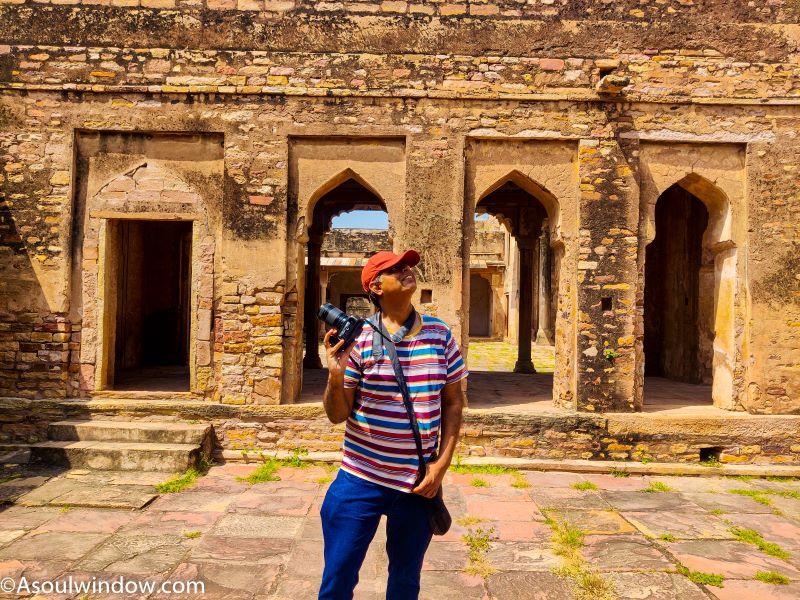
Shahjahan Mahal
Shahjahan Mahal is located right next to the Jehangir Mahal in the North East direction. A local guide can help you identify both the palaces. This palace was constructed by Shahjahan (1627-1658 C.E.), the Mughal ruler. This is why it was christened after him. The length and breadth of the Shahjahan Palace is around 98 x 52 metres.
This palace is worth a visit for its unique Mughal architecture. Perched atop a hill, much like the Mehrangarh Fort of Jodhpur in Rajasthan, the Gwalior Fort offers spectacular panoramic views of the bustling Gwalior city below. Did you know this fun fact about Gwalior Fort?
Shahjehan Mahal was built in the Mughal era and has a huge courtyard. These grand palaces are the finest specimen of typical Mughal art and architecture. The jali decorations, exquisite carvings on the walls and arched door are some of the tell-tale signs of the Mughal architecture. I entered the palace through a gate which opens to the huge Jauhar Kund and other to the Vikram Mahal.
Other places to see in Gwalior
The Gwalior Fort is located in the heart of the Gwalior city. The below mentioned sightseeing places are all located merely a few kilometres away from the Gwalior Fort. You can easily explore these tourist places in a day or two in a hired cab or autorickshaw. Local city buses also drop at these places but they take more time. Apart from the below mentioned places of interest, you can also visit Rani Jhansi Laxmibai Memorial, Jai Vilas Palace Museum, Baija Taal, Digital Museum, Maharaja Bada, Mohammed Gaus Tomb etc. These must-see places near Gwalior Fort are located in close proximity with each other.
Below are some of the best places to see near the massive Gwalior Fort.
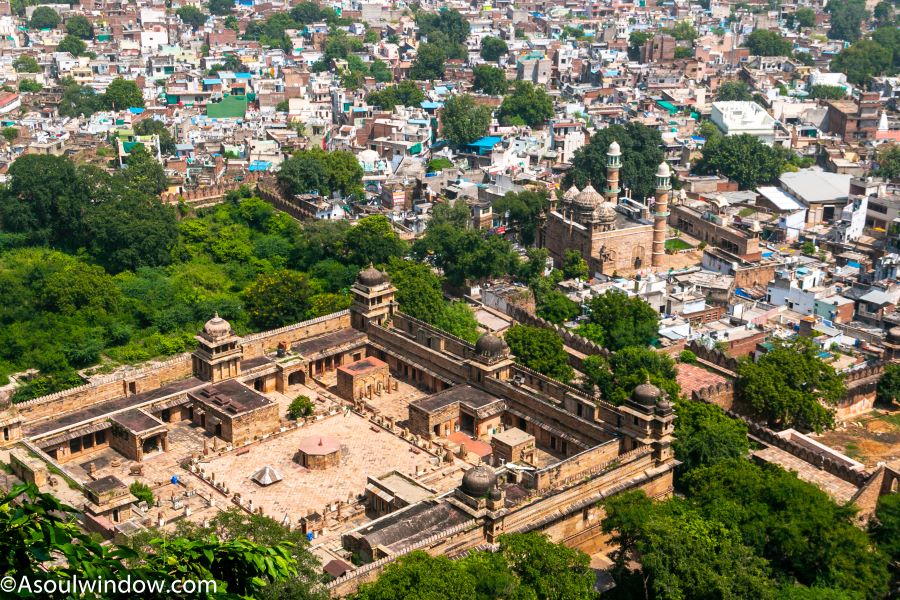
The Gujari Mahal Archeological Museum or State Archaeological Museum
King Man Singh Tomar had constructed a special palace for his wife Mrignayani. In present day, it has been turned into an impressive open-air museum. It was converted into a museum in the year 1922.
I lost track of time here as I minutely observed scriptures, artefacts and huge stone idols from the pantheon of Hindu deities. I particularly liked the huge statues of Hanuman ji. Hinduism or Sanatan Dharm is the 3rd largest religion in the world. Growing up in India, I have come to venerate a diverse and vast pantheon of Hindu gods and goddesses. Idols of most of them, especially those of Vishnu Bhagwan are on display in and around the courtyard of Gujari Mahal.
There is an underground museum inside the Gujari Mahal Archaeological Museumtoo. It is easy to miss. One of the conditions on which Queen Mrignayani married King Man Singh Tomar was that she would only drink the water sourced from her village call as Raai Gaanv. The King agreed to this and the remnants of the mud pipeline can still be seen in the underground museum. It is not easy to spot, so ask the local security guide to help you find it.
K.K. Muhammed sir also explained to us the unique architecture of a huge Varaha statue displayed inside the museum. This was easily one of the most beautiful statues of the Varaha I had ever seen. As I was preparing to leave the premises of the Gujari Mahal, a bunch of male peacocks strutted their stuff around and made calls, as if requesting us to stay longer.
Monalisa of India, anyone?
K.K. Muhammed sir wanted us to see a very special statue. He called us in a nearby room and announced, “We have all heard about Monsalisa. But did you know about Shal Bhanjika? Look at her idol carefully. The detailing of her face, the ornaments, dress etc has few parallels in the world.” This 1,000 years old statue of ‘Monalisa of India’ which costs crores of rupees, is displayed in the Gujari mahal Museum. It has participated in various international exhibitions.
Jain Rock Cut temples at Gopachal Parvat
My co-traveller Norina from Budapest in Hungary, Europe exclaimed, “This place reminds me of Petra in Jordan!” I have traveled to Jordan but I found the Gopachal rock cut temples more reminiscent of the Buddha statue in Bamiyan, Afghanistan. It was also very similar to the Buddha statues in Kargil, especially the Chamba statue in Mulbekh I visited during my road trip across Ladakh earlier. Gopachal is one of the top places to see in Gwalior apart from the imposing Gwalior Fort.
Gopachal Siddha Kshetra and Tirtha Kshetra is a famous pilgrimage since the Mahabharat era. It is a renowned Tirthankar Neminath and Tirthankar Parsvanath Deshnasthali. It is also the Nirvana place of Supritishhit Kevali.
The local pujari, who took care of the premises all by himself, was excited to take us to a locked cave. “It is the most beautiful and largest idol of Tirthankar Parsavanath in the world!”, he exclaimed as he could not hold his excitement. We followed him like schools on guided tours. At 42 x 30 feet, this idol of Tirthankar Parsavanath is the largest such image of the world. Lord Parsavanath is sitting in the Padmasan Mudra in this cave temple.
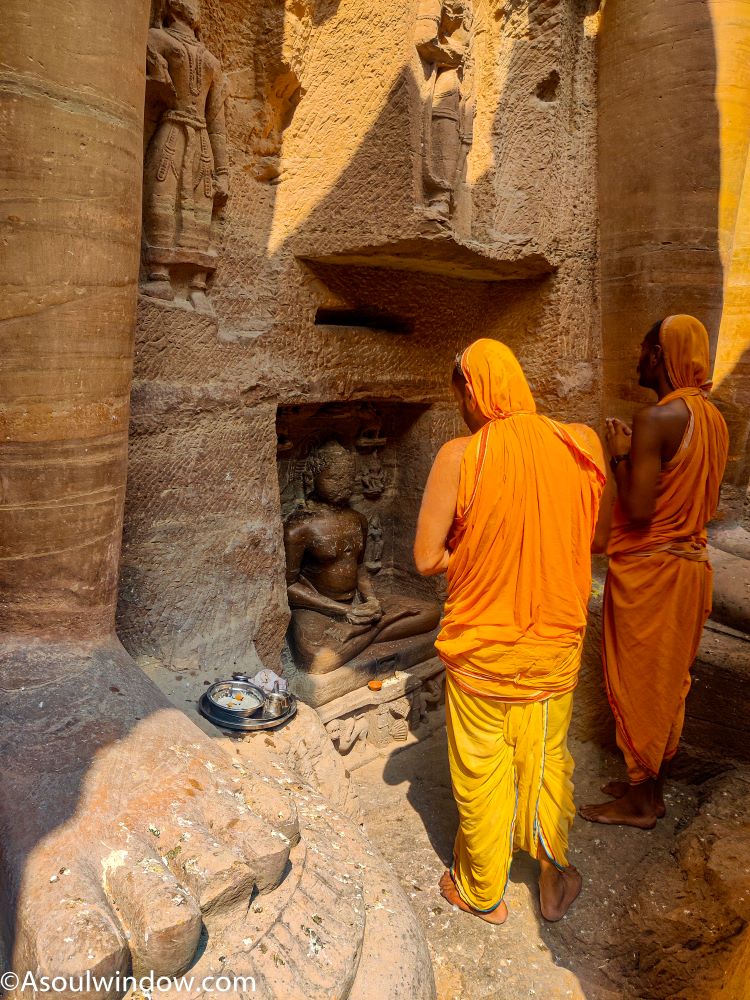
Gopachal is a very important Jain pilgrimage which is also a confluence of Jain Dharma, culture, art, architecture, and literature. It is also the Sadhana Sthali of Mahakali Raidhu. I was left slack jawed at the well-maintained colossal images of the Jain Tirthankaras in the 26 odd cave temples and Trikal Chauvisi on the hill top area accessed by a flight of stairs.
Rock Cut Jain Colossi in Gopachal Tirth Sthal
Rock Cut Jain Colossi is amust-seeplace.The Jain Rock Cut idols at the Gopachal Parvat are like nothing which I have seen before. Do not forget to pay a visit to these national protected monuments rock cut Jain colossi. The images in the Ek Pathar Ki Baoli are those of standing and seated Jain Tirthankaras, both large and small, sheltered in caves and niches. These are 26 in numbers and have inscriptions on their pedestals. These rare inscriptions refer to the name of the powerful king Raja Tomar Singh Dungar Singh (1425-59 C.E.)
Ek Pathar ki Baoli
Ek Pathar ki Baoli is one of the best hidden gems, located near the Gwalior fort. Ek Pathar ki Baoli is situated near the Cave number 1of Gopachal Tirth Sthal. This is a stepwell or a water reservoir. Few people talk about it. Fewer know about this offbeat place.

Baija Taal Cultural Complex
On the last day of Times Passion Trail, all the participants were facilitated at the Baija Taal Cultural Complex. It was a magical evening, what with cool breeze caressing my face even as the students of Raja Man Singh College of Gwalior hypnotized us with their soulful renditions of Dhrupad and Gwalior Gharana music.
I sat there, silenced by the brilliance of the classical music and wondered why we don’t talk about the music traditions of Gwalior which has merely few parallels in the world. As if by divine intervention, merely a few days after my visit, Gwalior was included in the list of 55 new cities to join UNESCO creative cities network. It is high time people travel to Gwalior for just its music!
The beautifully lit Baija Taal is located in the heart of Gwalior City. It is more like a hangout area for the locals. During my visit, I saw many local people enjoying the boat ride here. The festive atmosphere here is infectious. Used for ceremonies and celebrating festivals, Baija Taal cultural complex also has an art gallery and open-air theatre.
Gwalior Digital Museum
As I was swallowed by the Digital Museum of Gwalior near Maharaja Bada, I found myself engulfed in the world of history, handicrafts, instruments, jewelry and other things of Gwalior displayed in several galleries using state-of-the-art IT equipment.
The Gwalior Digital Museum is a very unusual tourist attraction. Developed by Gwalior Smart City, it is a must-see tourist attraction. It is the first center of its kind in Gwalior and the Bundelkhand region. It is already very popular with school kids and tourists.
In the unique Gwalior Digital Museum, the various architectural styles, costumes, space related objects, lifestyle, musical instruments, jewelry, handicrafts, cultural tradition, painting and many genres of paintings have been digitally displayed in a modern way.
Constructed on a plot measuring 3,500 square feet, the Digital Museum of Gwalior is divided into 16 galleries. I was impressed to see the museum exhibiting the heritage in modern and Digital way.
Free clean toilets are available within the museum premises. Gwalior Digital Museum is located very close to nearby tourist attractions such as the beautifully illuminated Maharaja Bada, Topi bazar, Jiwaji Chowk and several colonial heritage buildings such as the Town Hall etc. These places are best visited in night when it is lit.
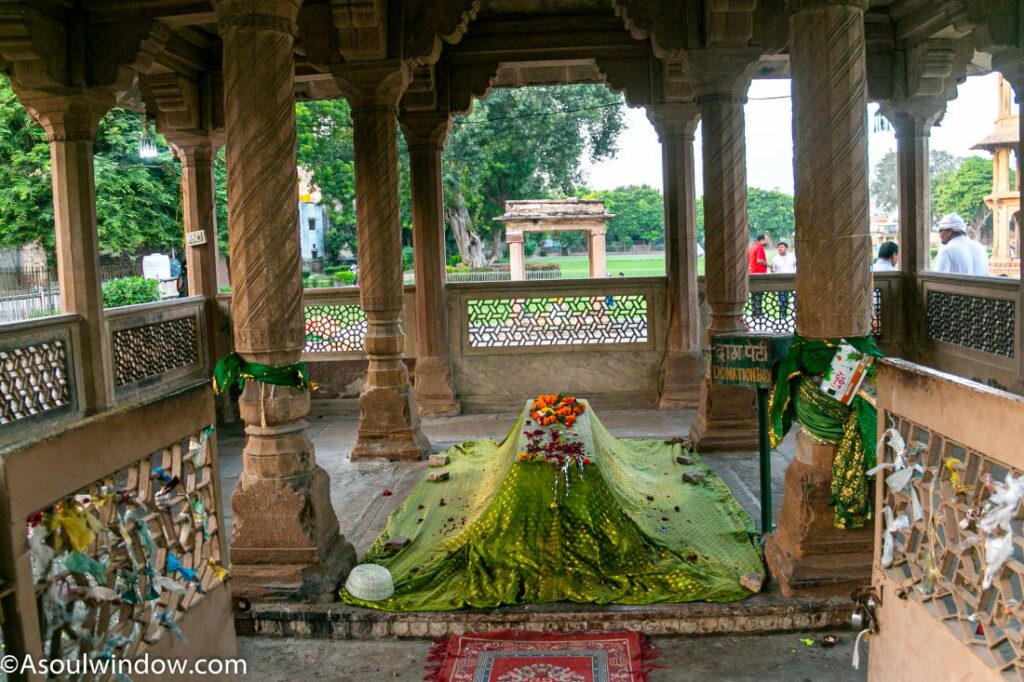
Tomb Of Tansen
As I stepped upon platform where Tomb of Tansen existed, my friend Niharika remarked, “Have you chewed the leaves of that ancient tamarind tree near the tomb? It is said that one who chews these leaves are blessed with a sweet voice. Many singers and musicians chew these leaves even today, hoping for a robust voice”. I picked up few leaves and chewed. I even tried singing but much to my disappointed I sounded just as surila as Anu Malik on a bad day. Never mind! I walk around the tomb of Tansen and wished we had video records of him singing.
The Tomb of the famous Mughal musician was constructed in the 16th century C.E. Tansen, as is widely known was a Hindu and one of the 9 gems of Mughal ruler Akbar. Constructed on the rectangular elevated platform with a pillared gallery, this is a must visit place near Gwalior Fort. The tomb lies right in the center of the gallery which has a roof but no walls. The larger Mohammed Gaus Tomb is located right next to the tomb of Tansen.
Top things to do in Gwalior Fort
What are some of the best things to do in Gwalior Fort? Below are some of the most popular things to do in Gwalior Fort:
- Visit Johar venues
- Visit several palaces
- Monument hopping
- Visit medieval temples
- Soak in the panoramic views
- Study the various architectural styles
Poetry and drama in and around Gwalior
On the last day, I visited more hidden gems of Gwalior which included rock cut temples at Gopachal Parvat, Rani Jhani Laxmibai Memorial, lunch break at Panchvati Gaurav, Jai Vilas Palace Museum, Baija Taal and Maharaja Bada.
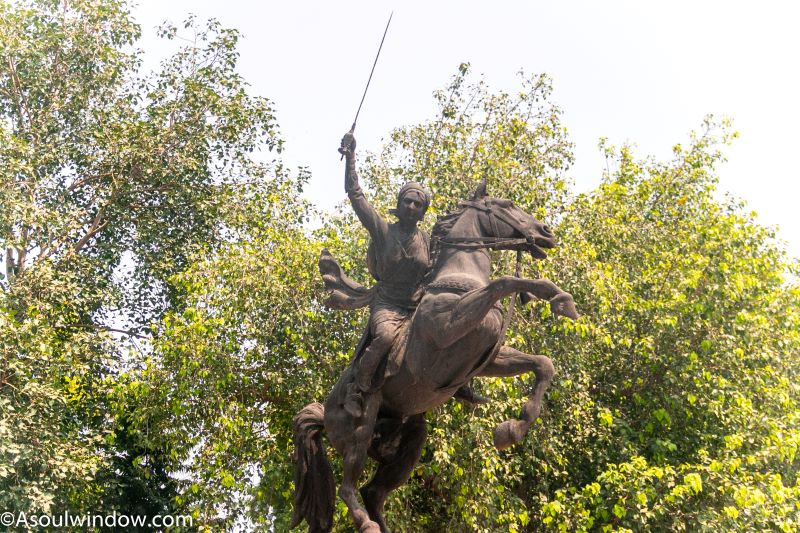
The day started with visiting the hilltop rock cut temples at Gopachal Parvat. The Gopachal rock-cut Jain monuments is located in the heart of Gwalior city.
Some of the top tourist places to visit near Gwalior Fort are Tansen Memorial (1 km), Bir Singh Palace (76 km), Madhav National Park (122 km), Orchha (123 km), Bateshwar (123 km), Khajuraho (279 km), Panna National Park (360 km), Sanchi (394 km).
Excursions from Gwalior Fort
There is no dearth of amazing sightseeing places in and around the Gwalior Fort. Some of the tourist places around Gwalior Fort include the destinations such as Narwar Qila, Tatya Tope Memorial Stand, Madikheda Dam and Reservoir, Bhuro-Kho Tower, Bhuro-Kho Jal Mandir, Pohari Jal Mandir, Chaparghat, Bhadaiya Kund, Tunda Bharkha etc. These are lesser-known excursions.
Some of the best well -known excursions near Gwalior Fort are as below.
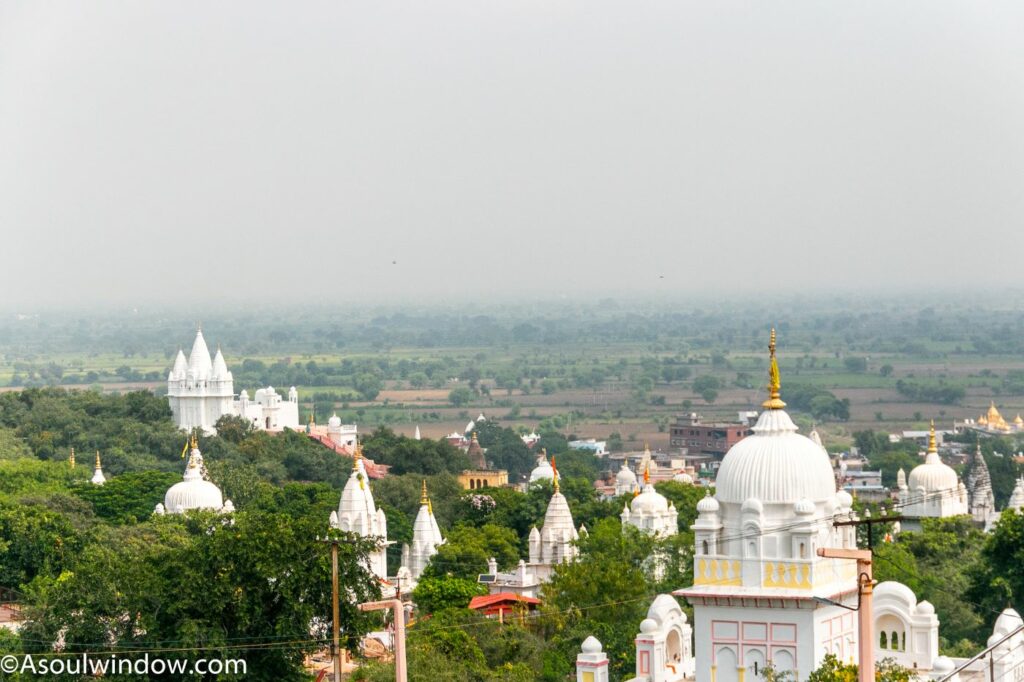
Sonagiri Jain Temples
Even before I reached the Sonagiri Jain temples, I was left gobsmacked with what I saw from the moving bus. “What are those on the top of the hills?”, I asked my local tourist guide excitedly. “This is where we are going to.” He said! What looked like a utopian castle straight from the fairy tales turned out to be a very important Jain pilgrimage.
The literal meaning of Sonagiri is: a mountain (‘giri’) of gold (‘sona’). It indeed is a mountain of gold. NO matter which direction I saw, hundreds of white Jain temples in unusual architecture greeted me. Thousands and lakhs of devotees and ascetic saints visit Sonagiri everyday in order to practice austerity, self-discipline. Attaining moksha (liberation or salvation) is also the goal of many devout Jains.
Many temples of the Sonagiri Jain Tirth date back to 9th century C.E. You can also visit a Jain Museum here. I offered my prayers to the 11 feet or 3.4 metres tall idol of Chandraprabha or Bade baba in the temple number 57, also the main temple in Sonagiri. The views of the green valley and nearby hills from the huge terrace in front of this temple is spectacular. I was surprised to learn that former US president Bill Clinton and many other presidents from European nations have also paid a visit to Sonagiri.
It was not possible for me to visit all the 77 Jain temples spread across the hills due to lack of time. However, I was able to visit some of the most stunning temples here. Few of them are also decorated with colourful tiles while others have dramatic spires.
You need to climb many stairs to reach the top. Some of my friends also used the palki (palanquin) service offered by local men. You can also participate in the annual ratha yatra at Sonagiri if you visit here after the festival of Holi from Chaitra Pratipada to Rang Panchami.
The courtyard of Temple number 57 of Sonagiri was also where I was interviewed by the team of one of India’s leading news channel Times Now about my overall experience of Times Passion Trails around Gwalior.

Sonagiri or Swarnagiri is located approximately only 60 kms away from Gwalior. You can reach Sonagiri through the Dabra-Datia Road. Gwalior-Jhansi Road is also nearby. You can also book a train to the Sonagiri Railway Station which lies on the Agra-Jhansi rail line.
Prehistoric Art in Chaturbhuj Nala
You can also stop by Mandsaur to appreciate the millennium old well-protected Prehistoric Art in Chaturbhuj Nala. Located in the Mandsaur district of Madhya Pradesh, it is a must-see place near Gwalior Fort. You can see as many as 560 man-made cupules marked on the walls. My co traveller Mr. Raj Kirtani told me about this hidden gem.
According to the Madhya Pradesh Tourism Website, these cup marks are anywhere between 1,00,000 to 2,00,000 years old. You can see the figures of humans, animals, birds etc here. Do not miss the pre-historic painted rock shelters at Chaturbhuj Nala.
Bhimbhetka rock art
I also visited Bhimbhetka, which is one of the most famous places for ancient prehistoric art in not only Madhya Pradesh but all of India. It is one of the best-preserved ancient arts I have ever seen in the world. The rock shelters, figure of a real palm of early man, figures of beasts and men going on war or hunting are some of the best highlights of this cave shelter. Do not miss it! It is located very close to Bhopal. I saw similar petroglyphs and rock carvings inthepicturesque Wadi Rum in Jordan as well.
Tikla
You can also visit Tikla or Tikula which is a major archaeological site and ancient rock shelter, located 50 kilometres or 31 miles southwest of Gwalior on the Agra to Mumbai Road. Famous for its petroglyphs, it is a must-visit place. The rock painting here can be traced back to 3rd – 2nd century B.C.E. It is located approximately 170 kilometres or 110 miles, south of Mathura. And of course, it is not to be confused with Tikal, the Mayan ruins in Guatamela.
Raja Bir Singh Deo palace at Datia
Datia palace which is also known as Raja Bir Singh Deo palace has Seven floor and 400 chambers. It took approximately 8 years to build this massive palace. The first two floors in Datia Palace were reserved for armoury and defence. The 3rd floor here was reserved for entertainment while the 4th floor had guest rooms. 5th floor was made for the audience and the 6th floor was where the queens were supposed to live.
It was on the 7th floor where Jehangir stayed in a single, large room. I alternated between soaking in the breathtaking panoramic views of the city below and admiring the artwork in the 7th floor of this huge palace.

Did you know it was here that the history of India shaped? Not many people know that Abul Fazl could have been the next emperor of the then India instead of Jehangir had Raja Bir Singh or Vir Singh Deo Bundela (who later became the ruler of Orchha) not intervened. It is funny how no one talks about the phase when the rule of Akbar was almost toppled and his dearest friend killed by his own son.
It was Raja Bir Singh who assassinated Abu’l Fazl on 22nd August 1602 while he was coming back from the Deccan. Mughals were involved in a battle against the Nizam Shahis of Ahmadnagar back then. Abu’l Fazl used to continually oppose the accession of Prince Salim to the throne.
The plot to eliminate him was hatched by Raja Bir Singh and Prince Salim or Jehangir, the eldest son of Akbar. The convoy of Abul Fazl was attacked near Narwar which is located around 63 kilometres away from Bhopal, the present capital of Madhya Pradesh.
My guide told me that the severed head of Abu’l Fazl’ was sent to Salim as a trophy at Prayagraj. He pointed out to a small ruin from the 7th floor and exclaimed excitedly, “This is where the head of Abul Fazl was buried!” Abu’l Fazl’s body was buried at Antri, which is a small village located 25 kilometres south of Gwalior.
Despite being one of most important advisors in Akbar’s court, Abul Fazl was killed by the son of Akbar. Ironically, Shaikh Afzal Khan, son of Abu’l Fazl’ was later appointed as the governor of Bihar in the year 1608 by Jahangir himself.
Raja Bir Singh beheaded Abul Fazl in order to please Jehangir. Abul Fazl or Abu’l-Fazl ibn Mubarak, was a major threat to the accession of throne for Jehangir. My local tourist guide told me animatedly that when the Jehangir became the next Mughal King in 1605 C.E., he rewarded Bir Singh Deo by making him the King of Orchha and the Bundelkhand region. The Orchha kingdom was originally founded by the Bundela king Rudra Pratap Singh way back in the year 1501 C.E. Vir Singh Bundela helped the kingdom achieve greater heights.
Abul Fazl, a Sindhi writer, historian and politician is known for his works such as Ain-i-Akbari, Akbarnama and a Persian translation of the Bible. Fazl was also one of the Navaratnas or Nine Jewels in the royal court of Akbar. Needless to say, Akbar was crestfallen when he heard of the news of the assassination of his close confidante and friend.

Raja Bir Singh Deo palace was built for Mughal Ruler Jahangir but the latter stayed here for only one night after which the palace was abandoned. My friends told me about a similar story in the Jehangir Mahal in Orchha. This palace was also built by Raja Vir Singh Deo for Jehangir and similarly the latter stayed here for only one night. All said and done, the Datia Palace remains one of the grandest buildings which Raja Bir Singh Deo ever built.
I found the make-up rooms and concubine bedrooms the most amusing. The views of the huge lake and the village below from the make-up room was spectacular. I was impressed to see the colourful Bundela paintings on the walls and ceilings. These are still preserved in excellent condition. This needs more restoration though. Irresponsible tourists can easily touch and damage the delicate paintings on the easily accessible walls. It reminded me of my visit to Chitrashala, or Ummed Mahal, which is a part of Garh Palace in Bundi, Rajasthan.
Datia Palace which is a unique blend of medieval Rajput and Mughal architecture is grand in scale. It is indeed a pity that no one from the Royalty stayed here ever. As I climbed up, my guide pointed out that even the two aala on the walls were made in typical Rajput style followed by Mughal style.
During the rule of Raja Vir Singh Deo between 1605 and 1627 C.E. he commissioned the construction of more than 52 palaces and monuments which can still be visited by the tourists. Datia Palace which is also called as Veer Singh Ji Deo Palace, Satkhanda Palace, Govind Mahal or Purana Mahal is located near both Gwalior and Orccha.
Temples of Morena
Do not forget to visit the amazing temples of Morena. On the same trip I visited temples like Bateshwar temple, Chausath Yogini Temple or Ekttarso Mahadeva Temple of Mitaoli, Garhi Padawali Shiva Temple andthebeautifulKakanmath temple. I was speechless at the temple architectural brilliance in this region. You can easily take a cab to these places of interest from anywhere in Gwalior. You can also visit a gazak factory for the famous Morena ki Gazak. Do read my complete guide to temples of Morena.
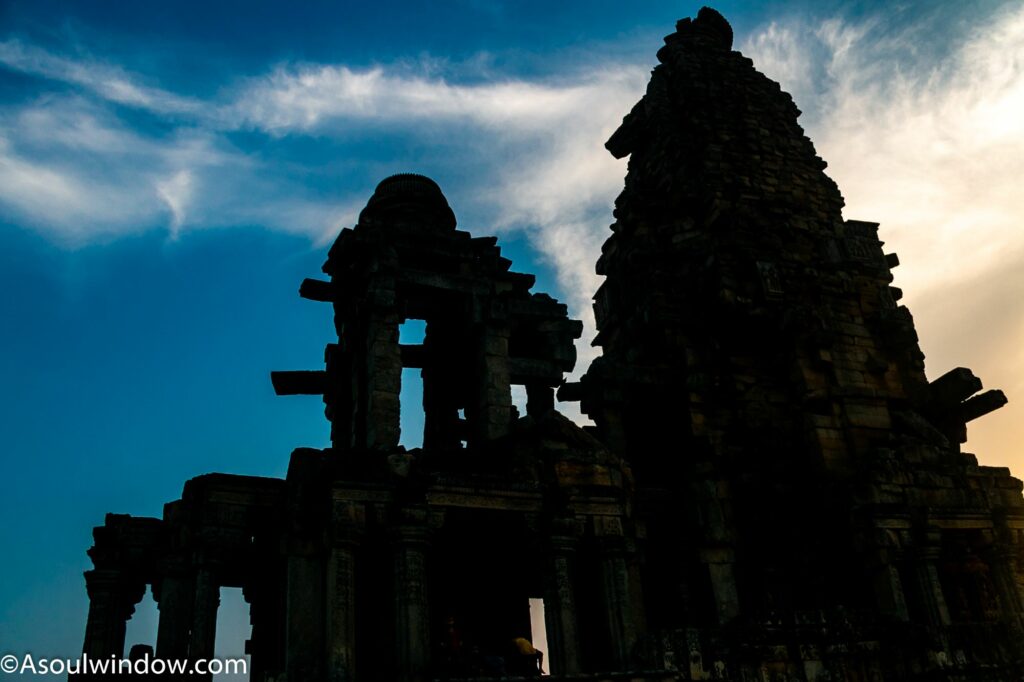
Scindia Chattri of Shivpuri
I came across an interesting signboard with two Cobras surrounding the image of a sun with eyes. It said,
“This Chhattri to the memory of the late Lieutenant General Maharaja Sir Madho Rao Scindia Alijah Bahadur G.C.S.I., G.B.E., L.L.D., D.C.L. of Gwalior was commenced in the year 1926 (Samvat 1982) by order of the council of Regency.
The foundation stone was laid by His Highness Maharaja Jiwaji Rao Scindia Alijah Bahadur on 6th January 1926 (Samvat 1982) and completed in the year 1932 (Samvat 1989). The construction was carried out under the direction of Lieutenant Colonel Hashmatullah Khan KT Home member Gwalior Government and supervision of Rai Bahadur S.N. Bhaduri C.E. M.I.E. Supervising Engineer By Ashghar Ali Khan, Executive Engineer
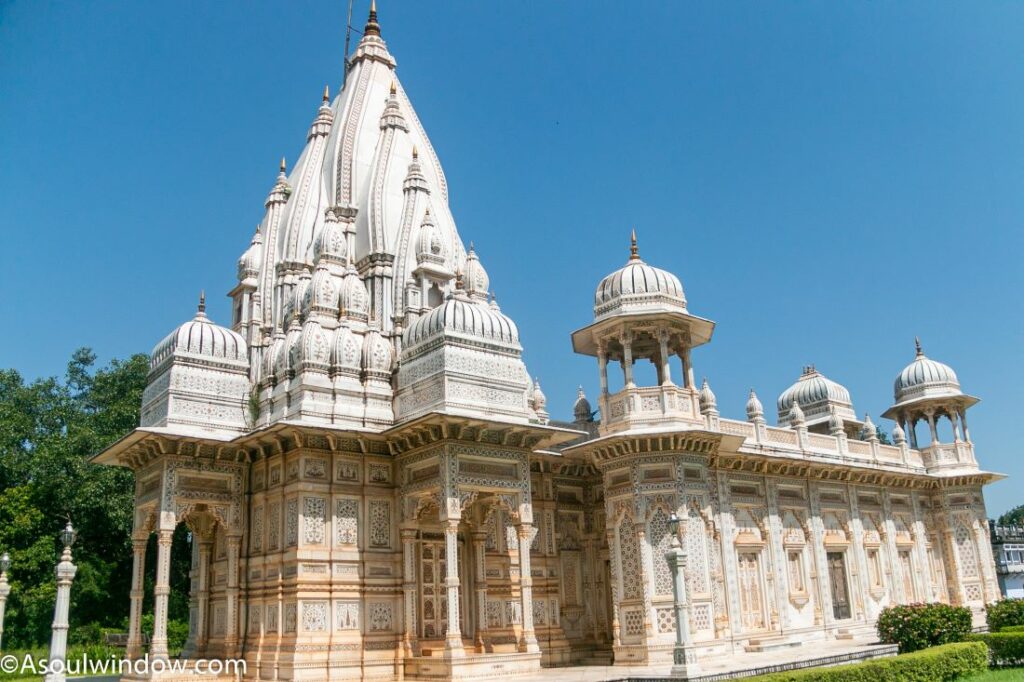
Madhav National Park
You can hire a safari jeep/car/gypsey in Madhav National Park. The wildlife safaris can be very expensive. But the best part is that if you are a solo traveller like me, then you can also book the slot of just one person for the price of a good burger. If you are in a large group, you can hire a mini bus which doesn’t cost much either. Since Madhav National Park is not as famous as other protected National Parks of Madhya Pradesh such as Bandhavgarh National Park, Pench National Park and Kanha National Park, the prices here are generally very low.
George Castle in Madhav National Park
George Castle is located deep inside the Madhav National Park. I visited at this bizarre British style structure in the middle of nowhere after a safari in the Madhav National Park where I saw wild boars, monkeys, neel gaai (blue ox) and many species of deer and antelope such as chital or spotted deer. “Come winter and you will see countless crocodiles basking under the sun by the shore of the lake.” said my local guide excitedly.
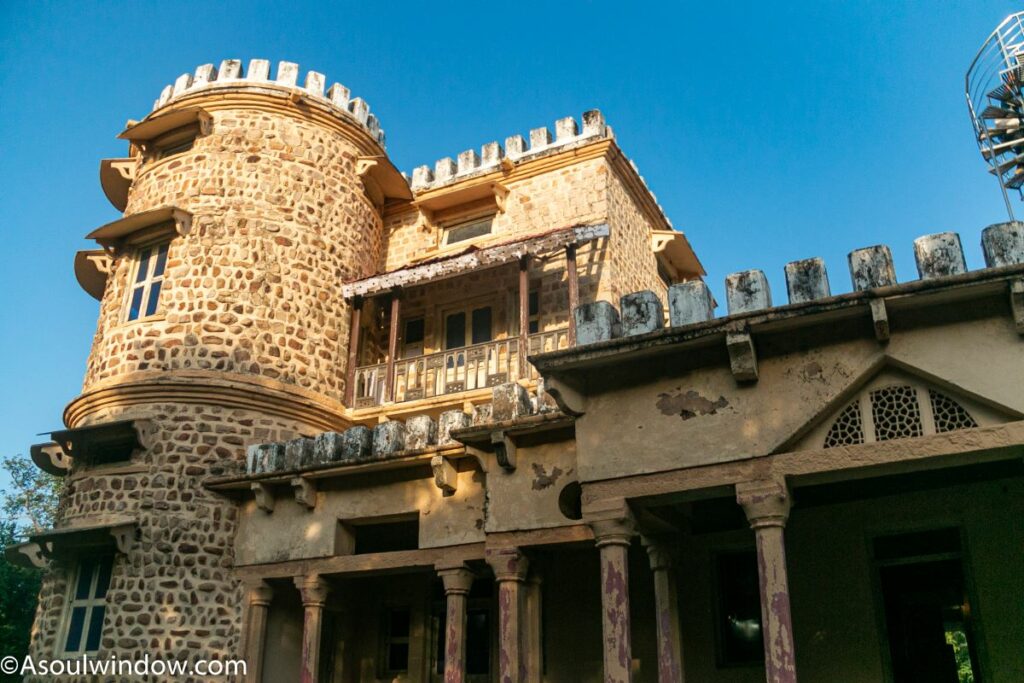
The George Castle is was built in the year 1911 by the then Scindia ruler of Gwalior. It was built to facilitate the overnight halt of King George V of England. He was supposed to visit the forest for a tiger hunt. However, he hunted the tiger on his way and never made it to the George Castle.
I had a breathtaking view of lakes and a panoramic view of the Kardhai forests from the top of the George Castle accessed by a spiral stair. From the top, I also observed the amusing M shape of the lake.
I also visited the rooms which are now turned into museums. But what I found the most intriguing is the bathroom. The bathtub, Belgian glass windows and Italian tile flooring stood out. It is amusing that these are still in good condition. Do not miss this unusual turreted English-style castle.
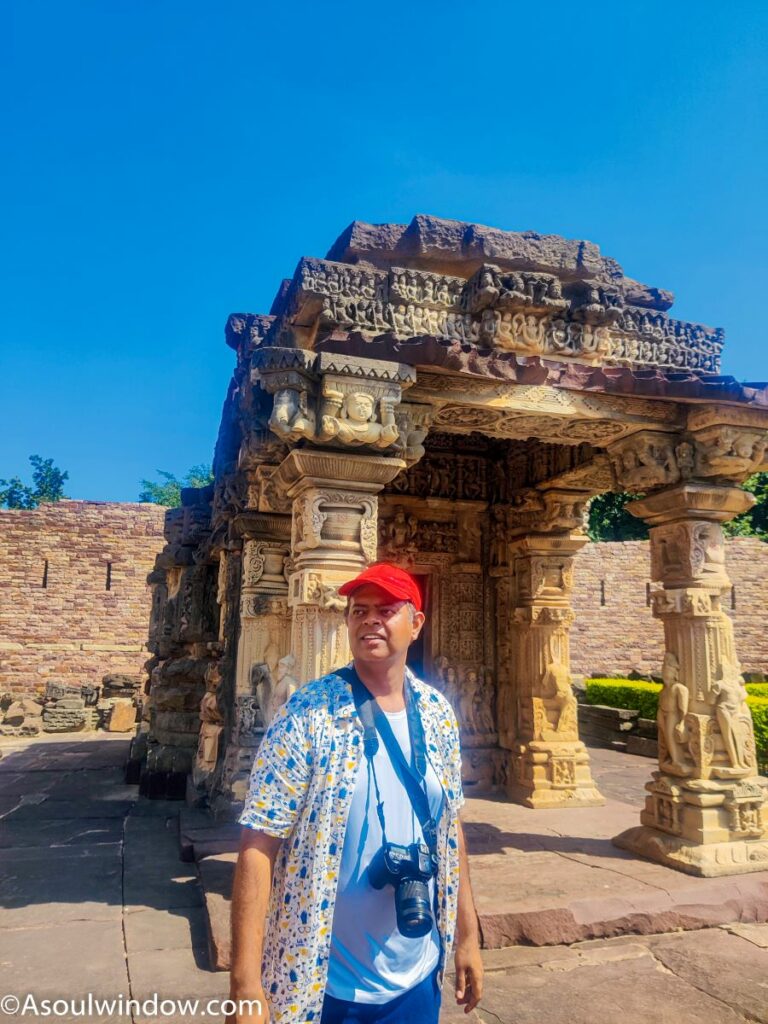
Surwaya Gadi
Surwaya Gadi is an ancient Indian school which was earlier known as Shankh Mathika and Saraswati Pattan. To protect the temples here from the attacks of the Mughals, the Shiv temple here was buried under sand. This is why the temple still stands today. It is said that the students who got their education here went on to carve the world-famous temples of the nearby Khajuraho. The Pandavas also stayed here during their exile or agyat vaas.
Located 20 kilometres away from Shivpuri on the Jhansi Road, there is also a monastery here. The structures here were constructed between 8th and 10th century C.E.
According to a stone pillar of 1357, Narwar’s Rajpal Jajpal Naresh Navbarman, Kadam Guhadhipati Purander constructed Saraswati Mandir by the orders of Ujjain’s ruler Raja Anantbarman by the end of the 13th century C.E. The temple was constructed for education and research of the Shaiva saints. There are buildings, bathrooms and sabhagar made of stone for Shaiva Math, Math’s president and students for studies. The floor mill which was operated by the bulls due to the increased number of students is still persisting here.
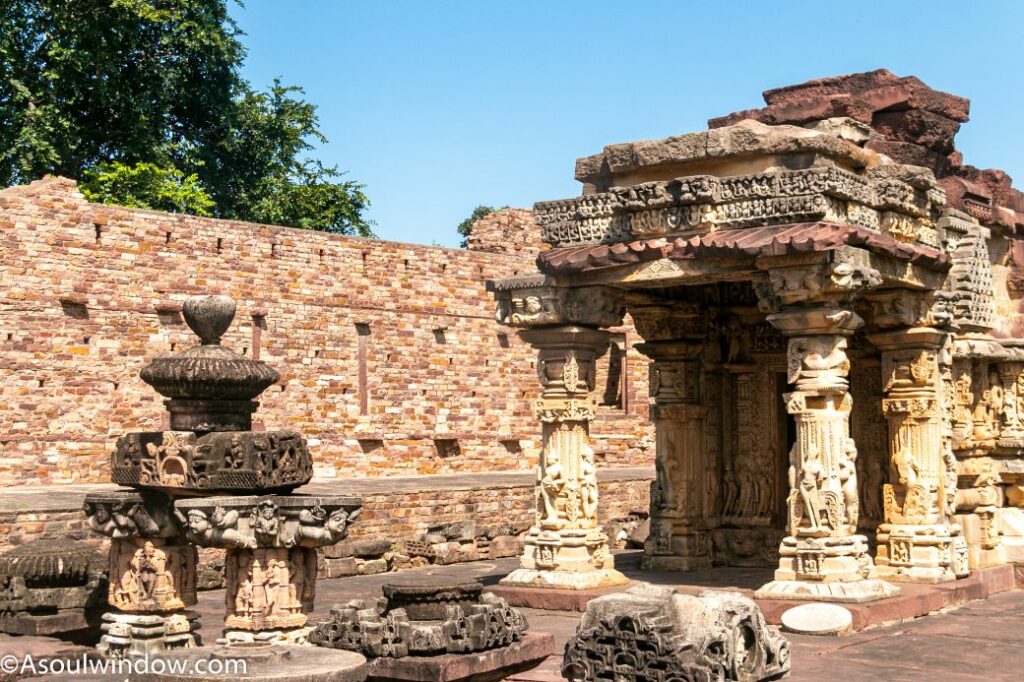
Shri Pitambara Peeth
I visited Shri Pitambara Peeth or Datia Shaktipeeth after the abandoned Datia palace. I was told by my local guide that Shri Pitambara Peeth is not only a major Shaktipeeth but also a ‘Tapasthali’ (place of meditation) of many luminaries. You will be surprised to know that the Shivling of Shree Vankhandeswar Shiva here is as old as Mahabharata. The same has also been confirmed by the Archaeological Survey of India after several studies and research.
Shri Pitambara Peeth is approximately 3 kilometres away from the Datia railway station, 75 kilometres away from Gwalior (Airport) and 29 kilometres away from Jhansi.
Some of the other places to see near Gwalior Fort are as under:
- Eran
- Jhansi
- Orccha
- Ater Fort
- Gyaraspur
- Vidisha-Sanchi-Udayagiri triangle
Festival of Gwalior Fort
Ramnavmi
During Ram Navami, a special festival is organised by the Jat Community at the cenotaph of Bhim Singh Rana by the Jat Community. Not many know that Bhim Singh Rana and Chhatar Singh belonged to the Jat Community.
Sikh Festival on Diwali
Every year in the month of October or November, the Sikh Sangat (community) from across the globe congregate at the bandichor Gurudwara and celebrate the safe return of the 6th Nanak, Guru Hargobind. He was released from detention from the Gwalior Fort around October 1619 C.E. I was amused to learn that the day coincides with the Hindu festival of Diwali or the festival of lights. It is a lesser-known fact. This makes Gwalior one of the best places in the world to celebrate Diwali or Deepawali.
Attend a live Dhrupad Baithak
I attended a live baithak where singers did excellent rendition of Dhrupad. This genre in Hindustani classical music hails from Gwalior. One of the earliest mentions of Dhrupad is found in Ain-i-Akbari by Abu Fazl (1593).
However, most of the mentions of Dhrupad are attributed to the musicians in the court of Man Singh Tomar (fl. 1486–1516) of Gwalior. In fact, there is no dearth of credible sources which point out that the origin of Dhrupad indeed can be traced back to the court of Raja Man Singh Tomar.
However, Dhrupad is older than it is believed to be. Dhrupad is mentioned as dhruvapada in the Natyashastra. (200 B.C.E. – 200 C.E.). Dhrupad is also mentioned in the chapter 33 of Book 10 in the Bhagavata Purana (800 C.E.–1000 C.E.). The Drupad songs I listened to live were devoted to Shiva Bhagwan. Dhrupad composition on Vishnu Bhagwan or one of his several avatar or incarnations is known as Vishnupad.
I feel that a visit to Gwalior is incomplete without attending a live concert of Dhrupad. Many luxury properties of Gwalior arrange for Dhrupad performances. You must also check for ant city events where they are performing Dhrupad.
Attend a live Gwalior Gharana Baithak
I was lucky to be invited to a live music concert at the touristy Baija Taal showcasing the music from the esteemed Gwalior Gharana. The event was organised by Gwalior Municipal Corporation. Surrounded by the lake, the stage came alive when the singers and musicians, both male and female belted out one classical song after another.
The Gwalior school of classical music rose to prominence during the rule of Mughal King Akbar (1542–1605). Sangeet Samrat Tansen, who also hailed from Gwalior, was one of the most famous vocalists of this music form, which is also one of the oldest Khayal Gharana. Attending a live concert of the Gwalior Gharana renditions under open sky transported me a few centuries away.
Vegan and Vegetarian Food in Gwalior Fort
We had amazing lunch buffet at the Fort View Cafe by Madhya Pradesh Tourism, located right next to the colossal Man Singh Palace. Bedmi Poori with alu sabzi served here deserves special mention. The Chaas served here refreshed me after all the walking in the sun. There are several food stalls located opposite the fort café from where you can pick cold drinks, biscuits, chips, namkeen, farsaan etc.
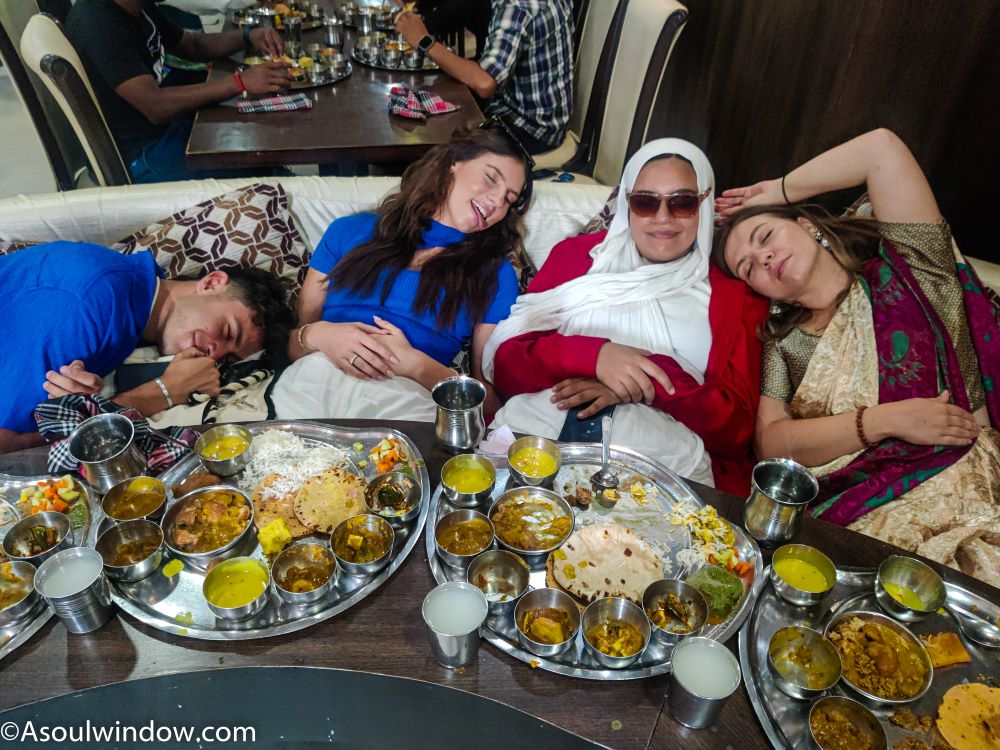
Night Life around Gwalior Fort
There are some cool pubs and bars in Gwalior you may want to check out.
Is it safe to visit Gwalior Fort?
Yes, it is very safe to visit the Gwalior Fort. Since the Gwalior Fort is a major attraction of the Gwalior city, you will always find hordes of tourists and security guards patrolling the fort premises.
Souvenirs Shopping Guide to Gwalior Fort
Apart from the local handicrafts, you can also buy the local Chanderi sari in and around the Gwalior fort. There is a souvenir shop known as Bundeli handicraft shop, located right next to the Fort View Café. You can buy nce hand-made knick-knacks and handicrafts from this souvenir shop. Some of the best Bundeli souvenirs to buy in Gwalior are
What currency is used in Gwalior Fort
INR is widely accepted at Gwalior Fort. Digital payment is also accepted at the souvenir shops and restaurants/cafes etc.
ATM in Gwalior Fort
While I didn’t see any ATM in the precincts of Gwalior Fort (ask around!), the Gwalior city has no dearth of ATMs. Gwalior is a pretty large city and a major tourist attraction of Madhya Pradesh in Central India. It is easy to find ATMs every few steps in Gwalior.
Photography Tips for Gwalior Fort
There are several hidden spots in the Gwalior Fort from where you can soak in sweeping bird’s eye view of the Gwalior fort. These hidden gems are also great for aerial shots sans the drone cameras. Here is a secret tip: I climbed on the top floor of the Jehangir Mahal and was rewarded with breathtaking panoramic views of Gujari Mahal and the sprawling Gwalior city down below.
Languages spoken in Gwalior Fort
Hindi is the most commonly understood and spoken languages spoken in Gwalior. English is also understood and spoken by many people inside and outside of the Gwalior Fort.
Toilet facility in Gwalior Fort
Clean toilets are available at the Fort View Cafe by MP Tourism. It is located at walking distance from the Man Singh Mahal.
Entry fee for Gwalior Fort
Gwalior Fort is a ticketed monument. You can buy entrance ticket from the famous Urvai Gate like I did. Prices are different for Indians and foreigner tourists. You also need to pay the camera fees here. Special permissions and rates apply for professional shoots. Entry fee is charged collectively to visit the historical sightseeing attractions such as the Raja Maan Singh Palace, Siddhanchal rock cut idols, Karan Mahal, Vikram Mahal, Jahangir Mahal, Shahjahan Mahal, Johar Kund, Bhim Singh Rana Ki Chhatri etc.
Hire a local tourist guide in Gwalior Fort
We had a local guide throughout the exploration of Gwalior Fort. He made us see hidden spots which we would have missed had we explored the fort by ourselves. I highly recommend hiring a local tourist guide in Gwalior Fort if you want to make your trip meaningful.
How To Book a trip to Gwalior Fort
You can either book the tour to Gwalior Fort through a local trip organiser. Many tour operators in Gwalior offer an all-inclusive trip across Gwalior and even nearby major tourist attractions such as the temples of Morena, Datia, Sonagiri, Shivpuri etc.
Backpacking Budget Travel Tips for Gwalior Fort
It is very easy to travel around Gwalior on a shoestring budget. If you are a budget traveller, you will find it very easy to see all the major sightseeing places in Gwalior on a low budget. Apart from finding low budget hotels, it is also easy to find a shared rickshaw almost anywhere in Gwalior. You can also have a hearty healthy meal at very low costs in Gwalior.
Solo Trip Tips for Gwalior Fort
With so many facilities regarding transport, hotels, sightseeing etc, Gwalior fort is an easy destination for the solo travellers like me. There is a lot which a solo traveller can do in and around Gwalior Fort.
Luxury travel Tips for Gwalior Fort
I travelled to Gwalior Fort in complete luxury. I stayed in the uber luxurious Taj Usha Kiran Palace. It was indeed a memorable experience!
Books on Gwalior Fort
Unfortunately, despite such rich history and culture, not many books have been written on Gwalior. I wish I could change that one day. Until then, read the below books on Gwalior for a deeper understanding. Some of the best books on Gwalior Fort are as below:
Where to stay in Gwalior Fort?
I had a memorable weeklong stay at the luxurious Taj Usha Kiran Palace, which is located right next to the HH Maharaja Sir Jiwajirao Scindia Museum, which is also known as the Jai Vilas Palace.
The Taj Usha Kiran Palace is a restored heritage building which was constructed in the year 1880 by HH Maharaja Jayaji Rao Scindia as a guest residence. Taj Usha Kiran Palace is located at a walking distance from the adjacent Jai Vilas Palace which is the ancestral home of the Scindia family. No wonder then that Taj Usha Kiran Palace has hosted several celebrities as well as Royalty and dignitaries on various occasions.
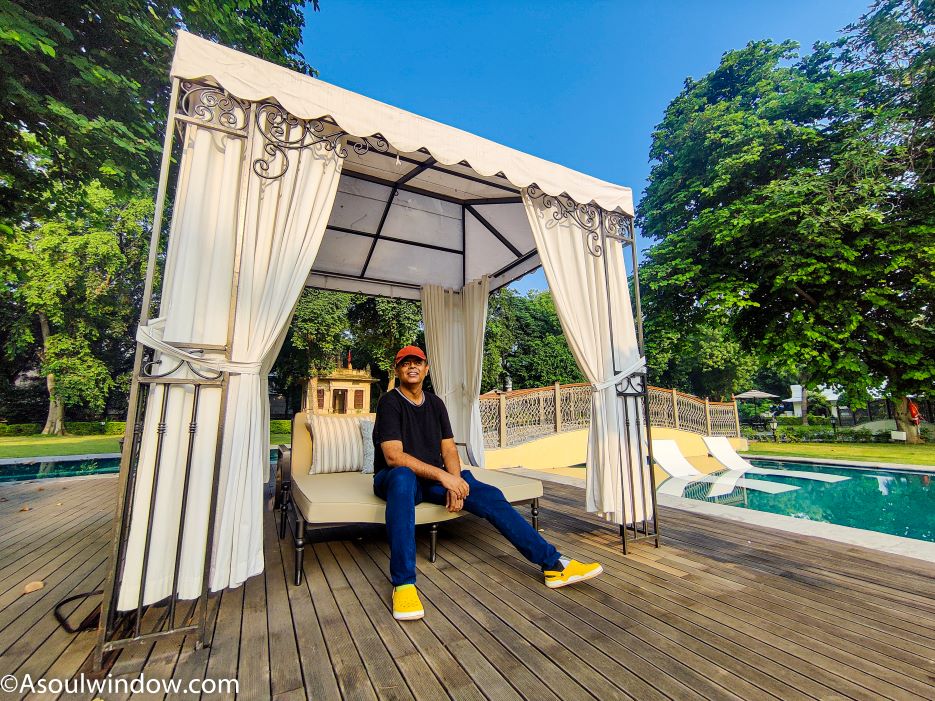
In fact, Mr. Jyotirao Scindia, Minister of Civil Aviation of India visited Taj Usha Kiran Palace for a swim during my visit. He is the son of late Shri Madhavrao Scindia. He is the grandson of Shri Jiwajirao Scindia, who was the last ruler of the princely state of Gwalior during the British rule in India.
During my week long stay at Taj Usha Kiran Palace, I enjoyed every moment here. On most mornings, I would wake up early and after a bath, start my day by offering prayers at the temples devoted to Shiva-Parvati ji and Ganesh ji. Located within the premises of the luxurious heritage hotel, the visit to these temples infused my day with positivity.
Although its stunning, I never used the swimming pool here. I loved that they had built recliners in the water for those who care. I am also impressed with the very attentive and friendly staff of Taj Usha Kiran. Being a hotel management student myself, I know what it takes to delight a guest and exceed his expectations.
I was surprised to know that one of my super juniors from Institute of Hotel Management, Lucknow who I never met worked here in bakery. The staff also helped me meet her for a quick recap of the good ol’ college days. I loved the lavish breakfasts at Taj Usha Kiran. While my friends stuck to fruits and ABC juices, I binge ate delicious poha, upma, vada, dosa and pasta. The Tiramisu served here, soft and delicious, is the best I ever had!
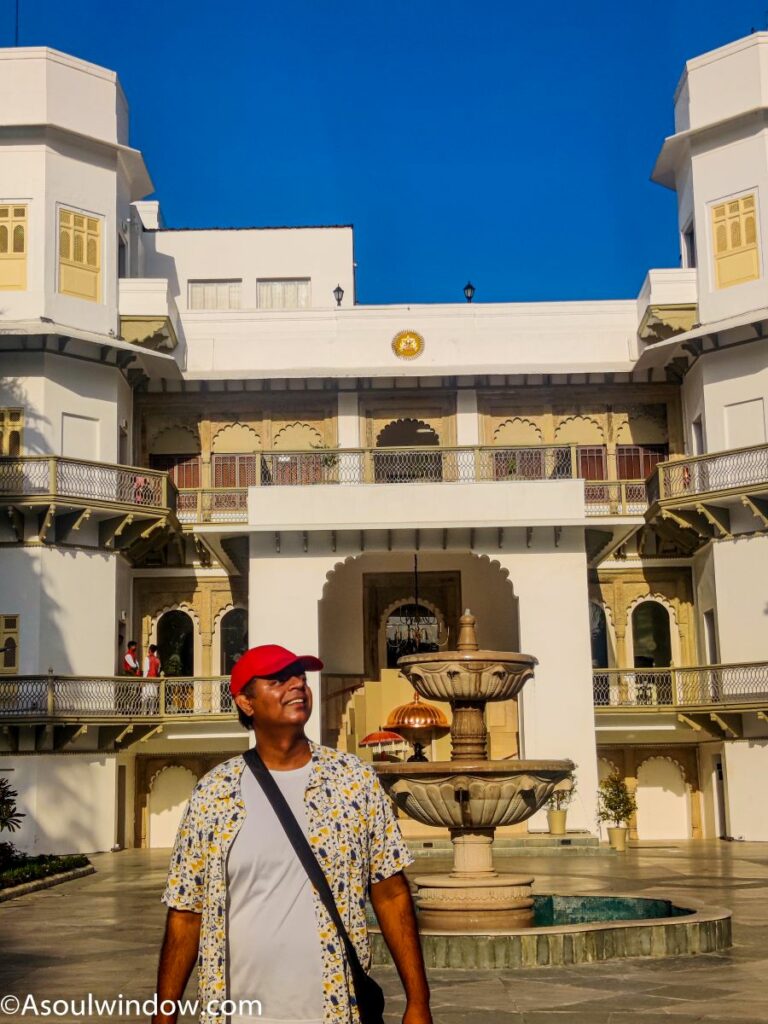
Coming to my room, I loved that how spacious it was. It was one of the hugest rooms I ever stayed in. Right outside my tastefully done up room was the huge balcony which overlooks the temples, swimming pool and al fresco restaurant down below. After a visit to the temples, I used to do my morning walks at the terrace and the sprawling lawns. Some of my friends also stayed at the luxurious glamping tents right across the pool. We also partied at the private cottage of Taj Usha Kiran here on one of the days. This also had a private courtyard and a small swimming pool! What’s not to love!
What to wear in Gwalior Fort?
I would suggest you to dress respectfully because there are many medieval temples across the Gwalior Fort premises. It would be great if you avoid sleeveless shirts, skirts and shorts. Wearing flip flops is also wise because you will have to keep your shoes outside while visiting the temples. Also, don’t forget to wear sunglasses and a good sunscreen when visiting Gwalior Fort because much of the monuments are out there in the open.
Timings of Gwalior Fort
As per the signboard at the fort, the Gwalior Fort is open for tourists from 9:00 a.m. to 5:00 p.m.
Best Time to visit Gwalior Fort
Best time to visit the Gwalior Fort are the months of October, November, December, January, February and March. This is when the weather is good. However, be warned of the extreme cold in December and January. (I love traveling during these months though!)
Duration of Visit in Gwalior Fort
How many days to spend in Gwalior Fort?
What can I do in 1 day in Gwalior Fort? I was easily able to see all the tourist attractions of Gwalior Fort within a day. I started early morning and by late afternoon, I was able to visit all the historical monuments, Johar Sthal and temples located within the Gwalior Fort precincts. However, visiting the Gwalior Fort in mere few hours is grave injustice in understanding the overwhelming history of this place. This place deserves more time and exploration.
What can I do in 2 days in Gwalior Fort? If you have 2 days in Gwalior Fort, you can do so much more. For example, there are a few pre historic cave paintings nearby which merits a visit. But many tourists miss it due to lack of information.
Quick Itinerary for Gwalior Fort
Below is the one-day Gwalior Fort itinerary I followed. You can also include Gopachal Rock cut group of temples and Chaturbhuj temple etc.
| Start Time | End Time | Sightseeing places |
| 08:45 | 09:15 | Travel to Gwalior Fort from Taj Usha Kiran |
| 09:15 | 11:30 | Visit Raja Maan Singh Palace |
| 11:30 | 12:00 | Refresh Break at Fort View Café |
| 12:00 | 13:00 | Visit Gwalior Fort Museum |
| 13:00 | 13:45 | Visit Saas Bahu Temple |
| 13:45 | 14:45 | Lunch at Fort View Café |
| 14:45 | 15:30 | Visit Teli ka Mandir |
| 15:30 | 16:30 | Visit Siddhanchal Rock Cut Statues |
| 16:30 | 17:00 | Travel to Gujri Mahal Museum |
| 17:00 | 17:30 | Tea Break |
| 17:30 | 18:30 | Gujri Mahal Museum |
| 18:30 | 19:00 | Travel back to Taj Usha Kiran |
| 20:00 | 21:00 | Dinner |
How to reach Gwalior Fort?
By Flight
The humble Gwalior Airport is located approximately 8 kilometres away from the Gwalior Fort.
By Train
The Gwalior railway Station is also located around 8 kms away from Gwalior Fort.
By Bus
Madhya Pradesh has a robust bus connectivity and excellent public transport system. Gwalior is well connected with neighbouring towns and cities such as Jhansi, Orchaa, Bhopal, Indore, New Delhi, Agra etc by bus service.
Local Transport for sightseeing in Gwalior Fort
Local buses, Taxis and three wheelers known as autorickshaws are easily available from other tourist attractions of the Gwalior city. Autorickshaws and cabs can drop you at the Urvai gate of Gwalior Fort from anywhere in the city. You may also drive your own vehicle within the Gwalior Fort complex because the monuments here are pretty spread out. Walking around the sprawling fort is exhausting and time consuming.
It is one of the largest forts in India with proper roads, much like the sprawling Chittorgarh fort near Bundi in Rajasthan. This is why many people visit all the tourist attractions of the Gwalior Fort in a car or a low-cost autorickshaw (great for budget travelers). We were a large group, so we explored all the sightseeing attractions of the Gwalior Fort in a bus.
Distances from Gwalior Fort
There are so many places of interest around the Gwalior Fort which you can include in your itinerary. For example, the Tansen Memorial is located only 1 kilometre away from the Gwalior Fort while Bateshwar is located merely 123 kilometres away from Gwalior Fort.
This distance chart will help you plan a week-long trip in and around Gwalior. Distances of major tourist attractions around the Gwalior Fort in ascending order are as below:
Distance between Morena and Gwalior Fort is 38 kilometres and it takes 1 hour via Mumbai-Agra National Highway.
Distance between Sonagiri Jain Temple and Gwalior Fort is 73 kilometres and it takes 1 hours and 20 minutes via NH44.
Distance between Bir Singh Palace, Datia and Gwalior Fort is 77.5 kilometres and it takes 1 hour and 20 minutes via NH44.
Distance between Jhansi and Gwalior Fort is 104 kilometres and it takes 2 hours and 10 minutes via NH44.
Distance between Kuno National Park and Gwalior Fort is 110 kilometres.
Distance between Shivpuri and Gwalior Fort is 119 kilometres and it takes 2 hours and 15 minutes via NH46.
Distance between Agra and Gwalior Fort is 120 kilometres and it takes 3 hours via Mumbai – Agra National Highway/Mumbai – Agra National Highway/Chennai – Delhi Highway or Srinagar – Kanyakumari Highway.
Distance between Madhav National Park and Gwalior Fort is 123 kilometres and it takes 2 hours and 30 minutes via NH46.
Distance between Orchha and Gwalior Fort is 123 kilometres and it takes 2 hours and 30 minutes via NH44.
Distance between Khajuraho and Gwalior Fort is 278 kilometres and it takes 5 hours via NH44 and NH39
Distance between New Delhi and Gwalior Fort is 339 kilometres and it takes 5 hours and 50 minutes via Yamuna Expressway.
Distance between Bandhavgarh National Park and Gwalior Fort is 380 kilometres and it takes 7 hours via NH39.
Distance between Bhopal and Gwalior Fort is 432 kilometres and it takes 7 hours and 30 minutes via NH46.
Distance between Satpura National Park and Gwalior Fort is 483 kilometres and it takes 9 hours via NH44.
Distance between Indore and Gwalior Fort is 509 kilometres and it takes 9 hours via NH 46 and NH52.
Distance between Kanha Tiger Reserve and Gwalior Fort is 602 kilometres and it takes 12 hours and 30 minutes via NH44.
Distance between Pench National Park and Gwalior Fort is 667 kilometres and it takes 12 hours and 30 minutes via NH44.
Distance between Tadoba-Andhari Tiger Reserve and Gwalior Fort is 859 kilometres and it takes 16 hours and 30 minutes via NH44.
Distance between Panna National Park and Gwalior Fort is 288 kilometres and it takes 5 hours via NH44 and NH39.
Distance between Sanchi Stupa and Gwalior Fort is 396 kilometres and it takes 7 hours and 35 minutes via NH44.
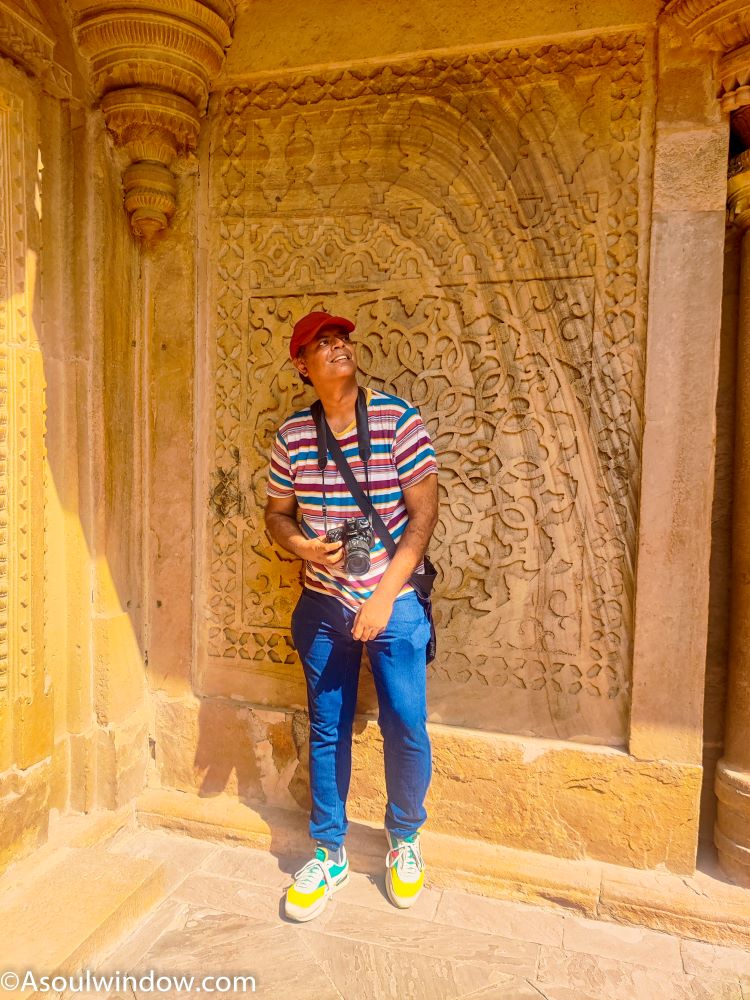
Conclusion: Is Gwalior Fort worth visiting?
Why visit Gwalior Fort? Here are my final thoughts in a nutshell. As I mined the annals of history in search of some lesser-known facts of the Gwalior Fort, it left me overwhelmed. There is so much to learn and see in Gwalior Fort.
The grandeur of medieval artefacts and impressive architectural designs are reasons enough to pay a visit to the imposing Gwalior Fort. This imposing fort is one of the most prominent landmarks in Gwalior Madhya Pradesh.
To summarize, Gwalior Fort is an important fort in not only Madhya Pradesh, but all of India. Not many people are aware of the fact that Madhya Pradesh has some of the most stunning buildings, Hindu temples, palaces and pavilions from the medieval era. It is high time; you pack your bags for an exclusive trail around Madhya Pradesh. Please share this blog with your friends and family, so that more people may benefit.
The view from my Soul Window left me wide eyed!
Pin this blog to save the blog and plan a trip later!
Related Blogs
Guide to fascinating temples of Morena
Birdwatching in Pench National Park
Biggest Ever Guide to Pench National Park
Biggest Ever Guide to Satpura National Park
My first Tiger Safari at Bandhavgarh National Park
Top Travel Blogger from India
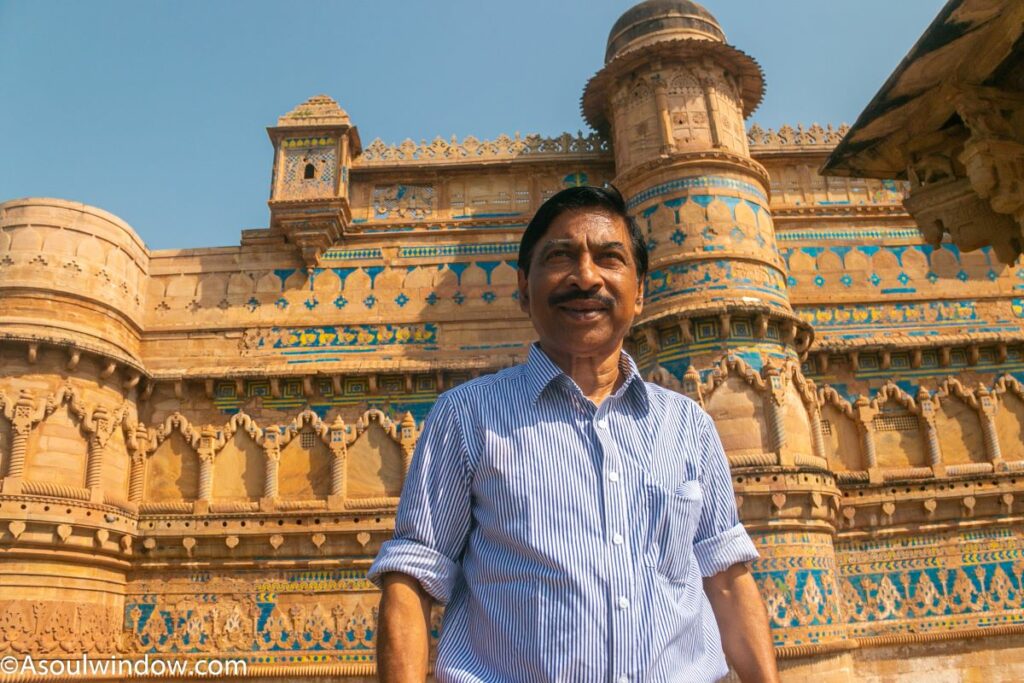
How do u know KK Muhamad sir, pic posted in article
I travelled with him. Pls read the blog again.
Very nice blog. After going through the article, I realized that I perhaps missed several aspects of the Gwalior, detailed in your blog. I shall suggest everybody to go through this article before visiting Gwalior Fort. And further more…. The photos you have captured are very beautiful.
Gwalior Fort, a majestic hill fort in Madhya Pradesh, India, boasts a rich history dating back to the 8th century. Its architecture seamlessly blends Hindu, Muslim, and Jain influences, showcasing intricate carvings and structural brilliance. Serving as a strategic stronghold for various dynasties, including the Tomars and Mughals, the fort witnessed centuries of power transitions. Its iconic Sas-Bahu temples and towering Man Singh Palace are testaments to its cultural significance. Gwalior Fort stands as a living testament to India’s diverse heritage, symbolizing resilience and architectural prowess through the annals of time.
Thank you for your kind words!